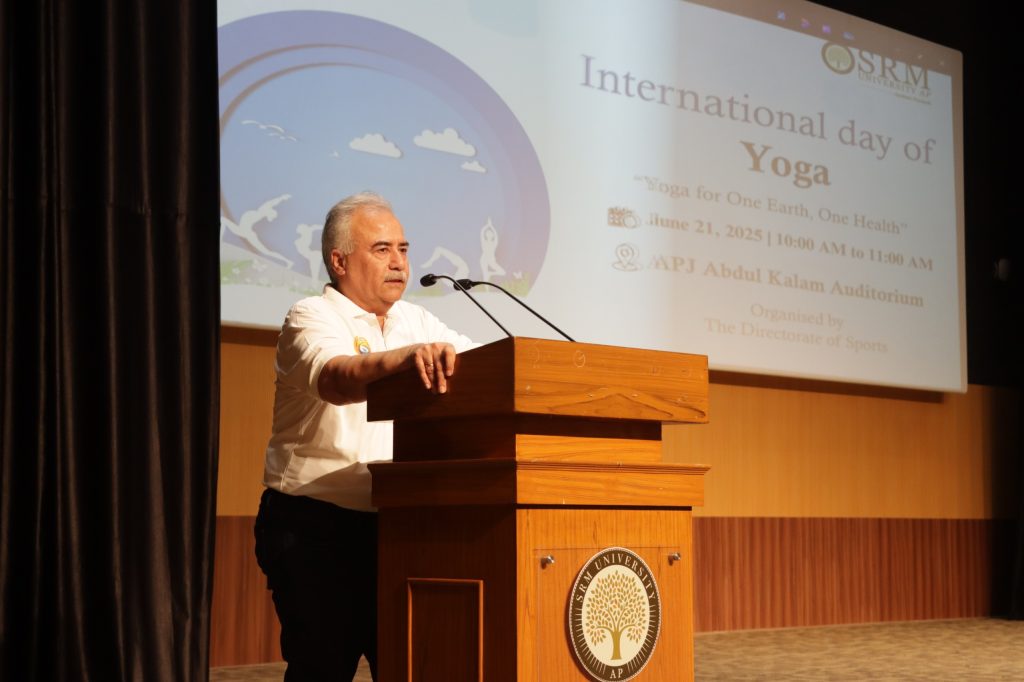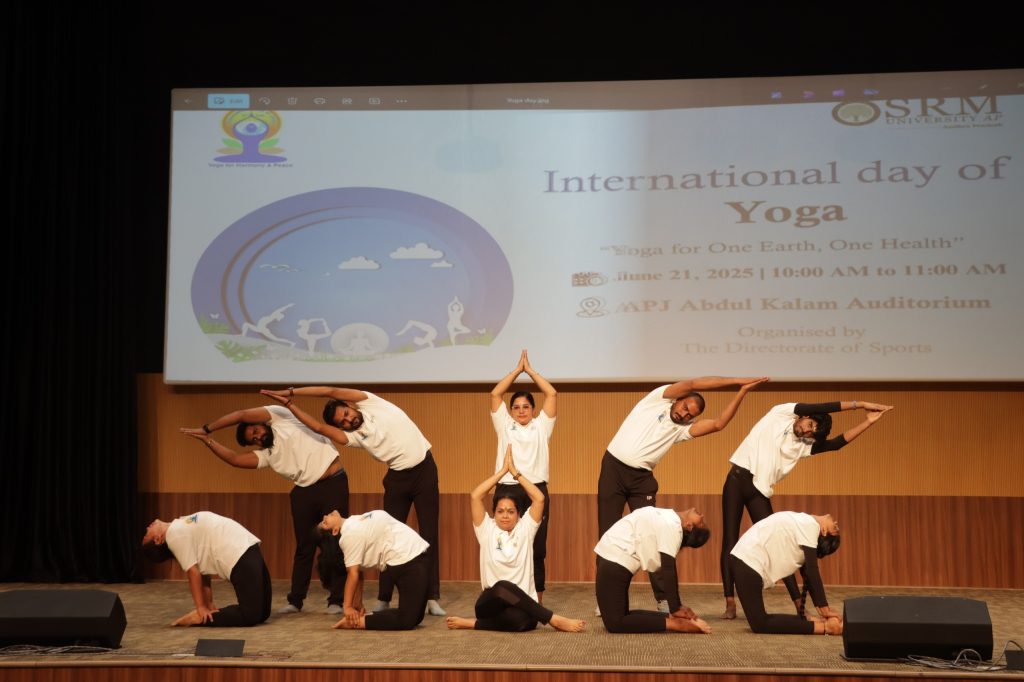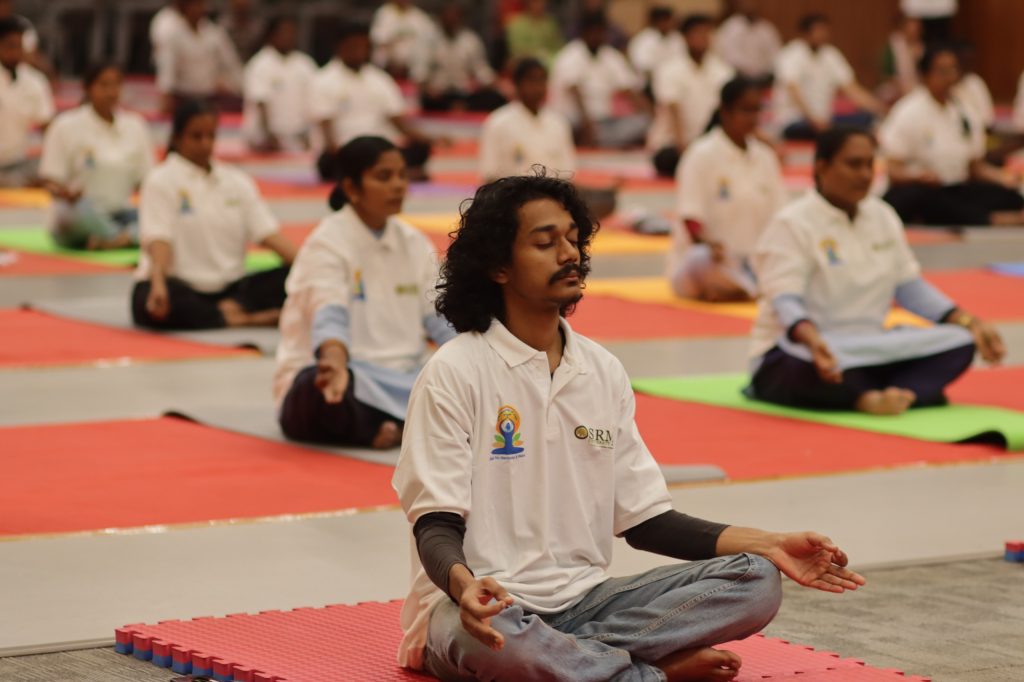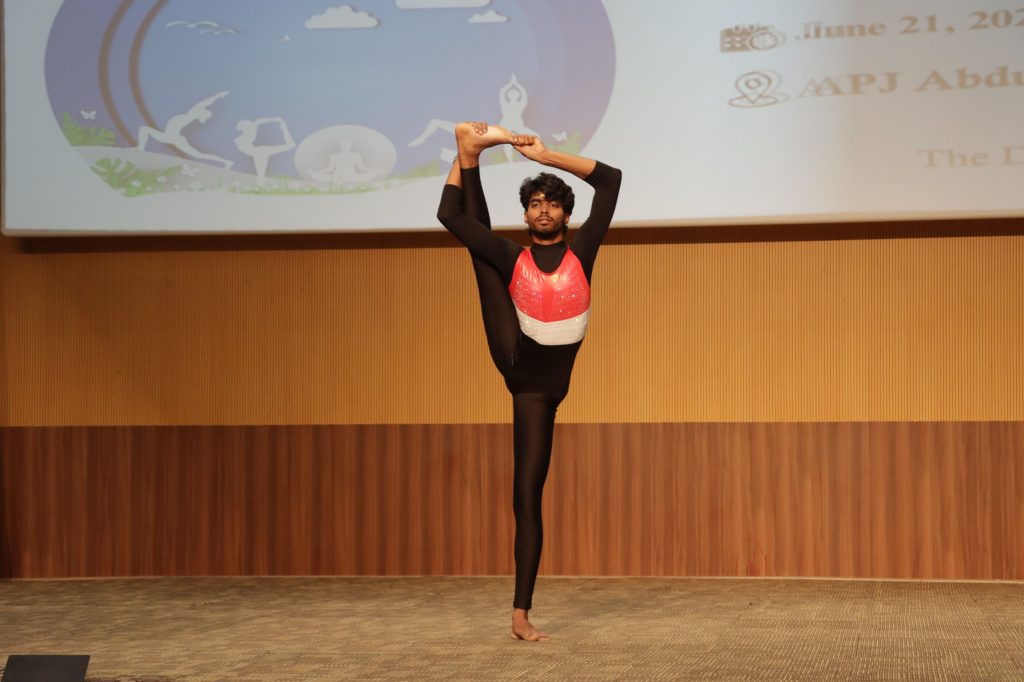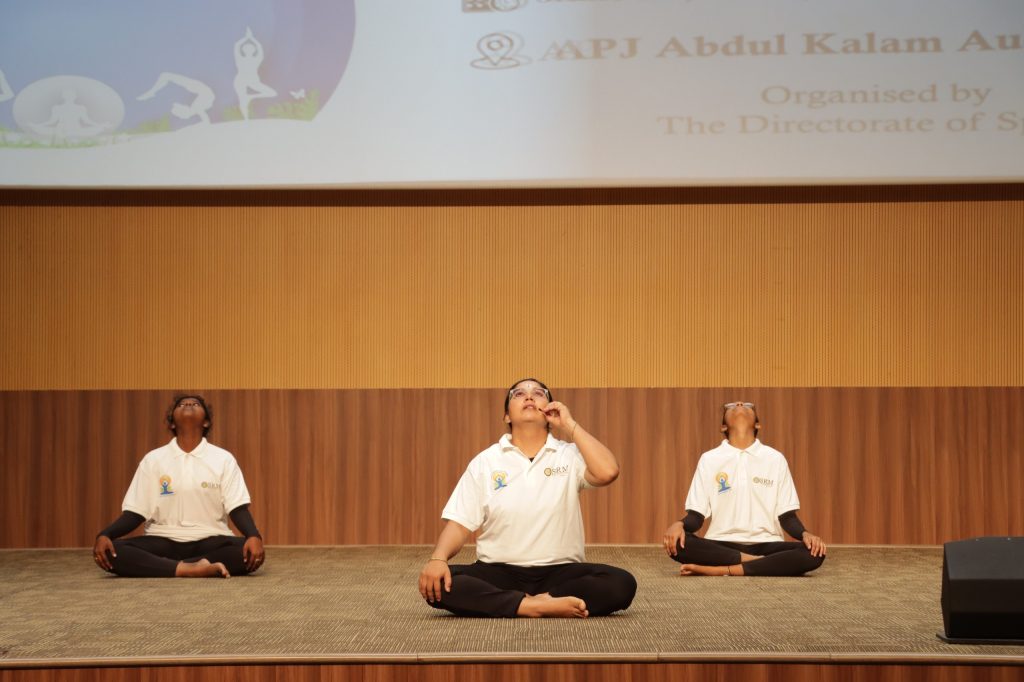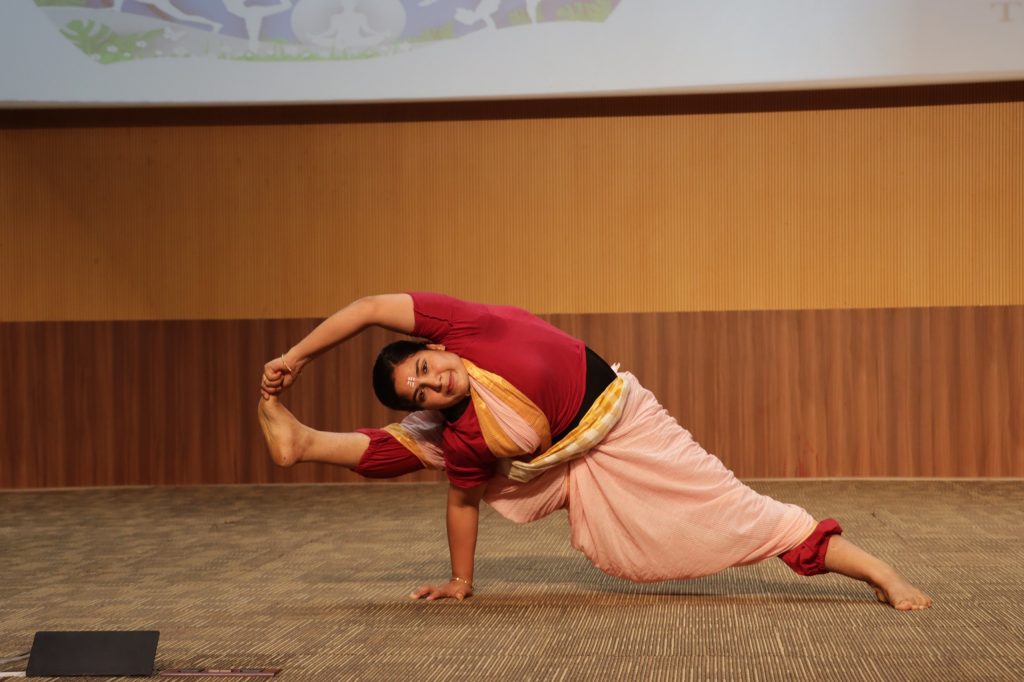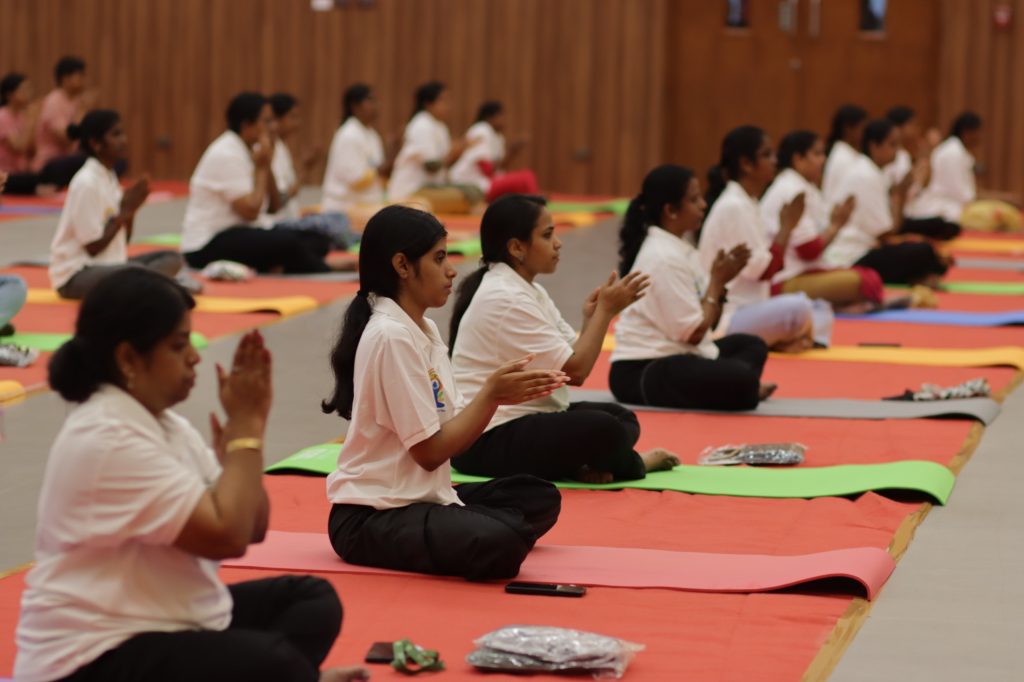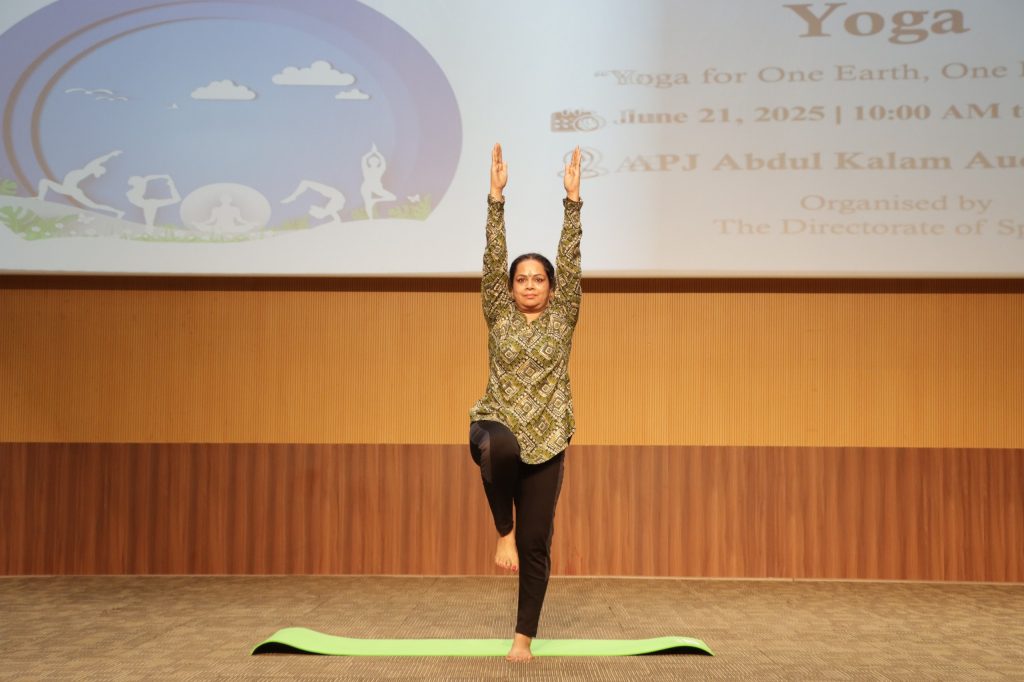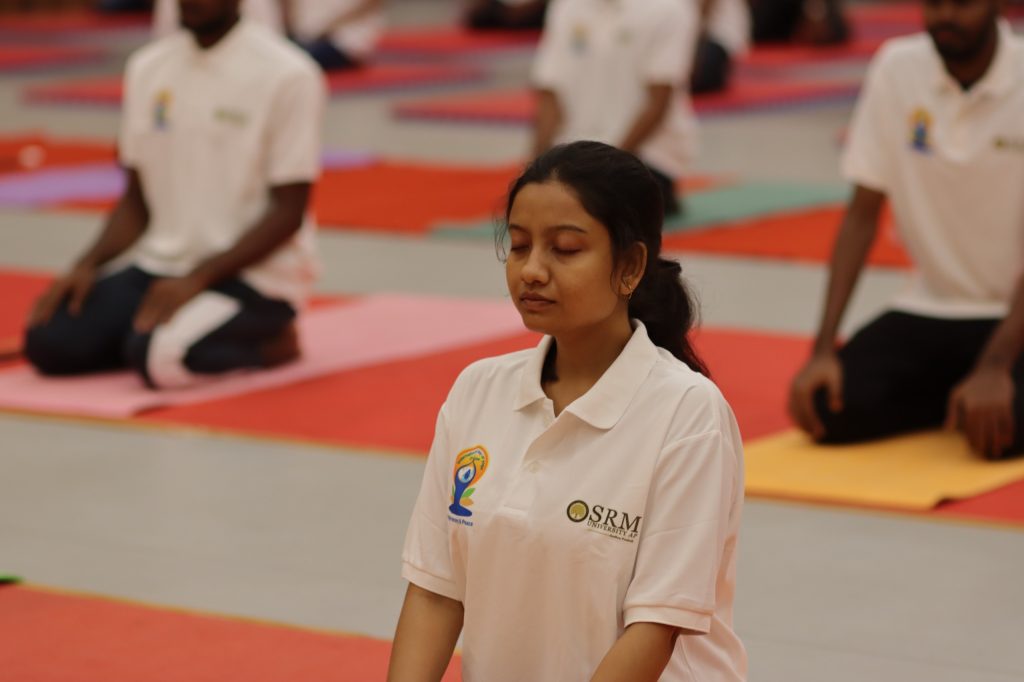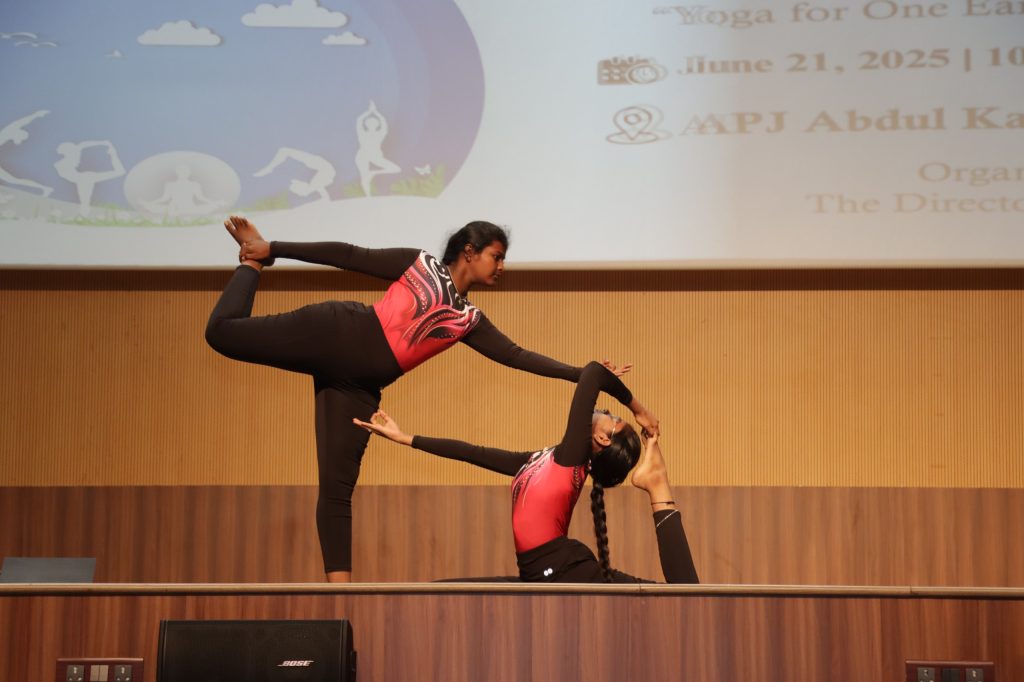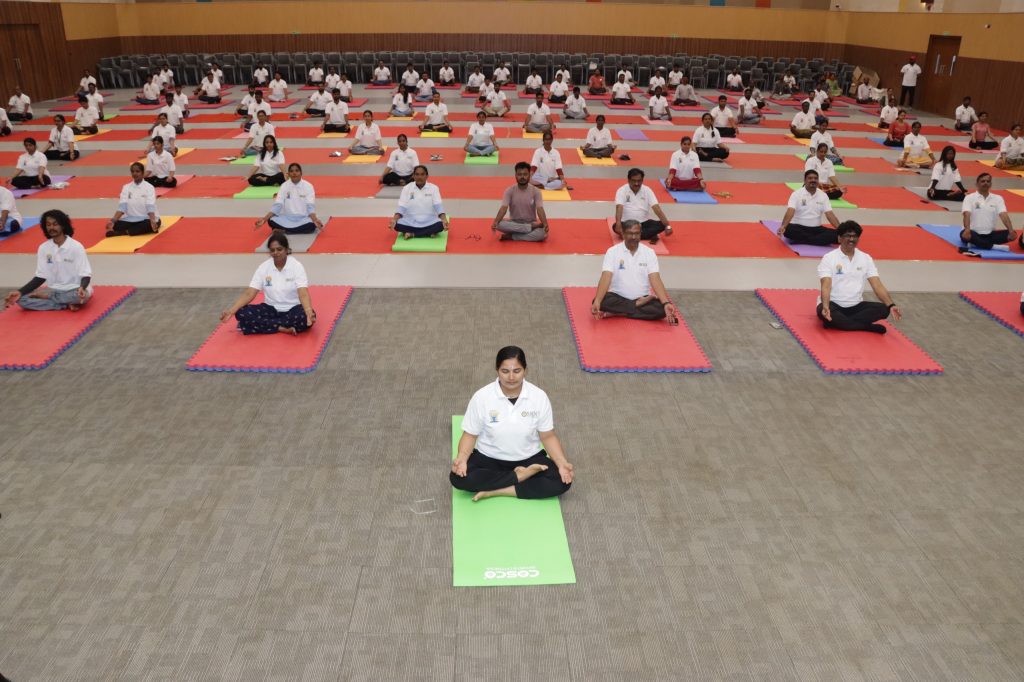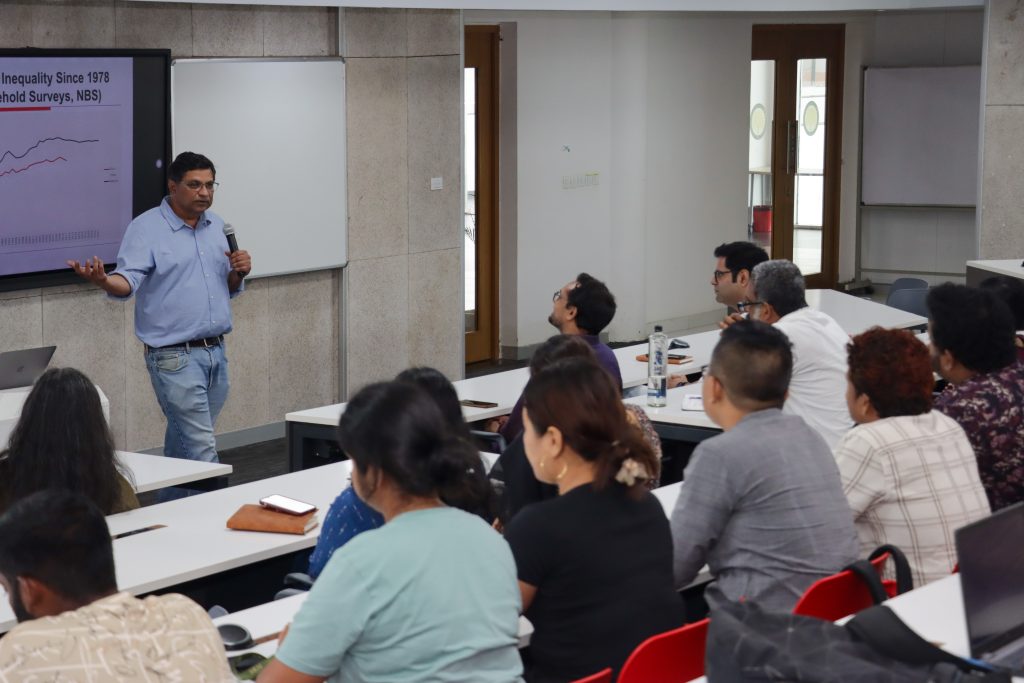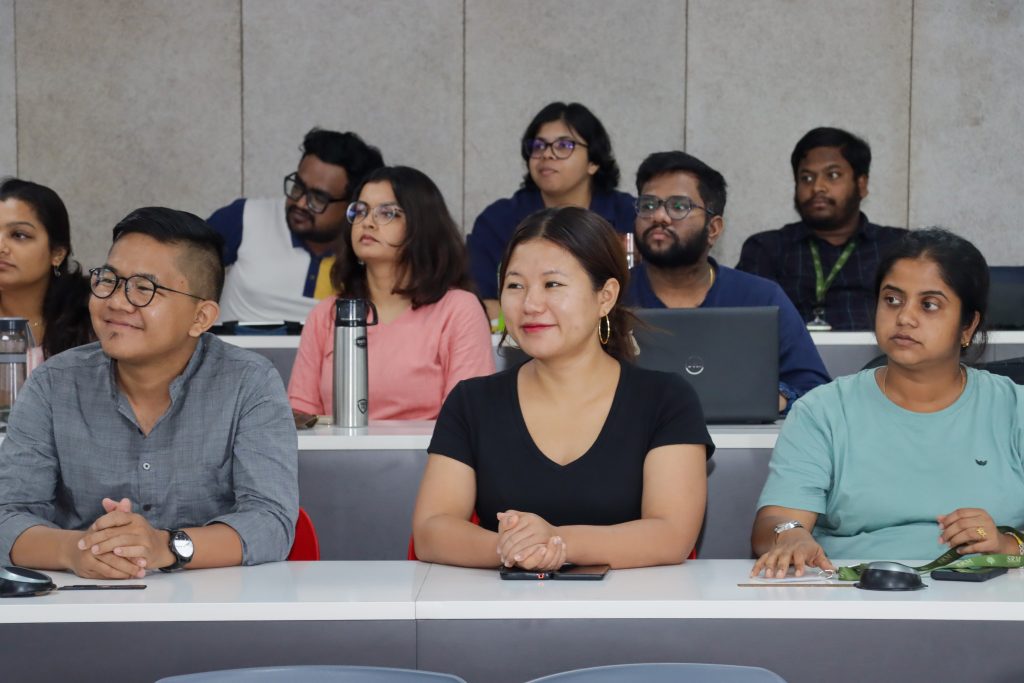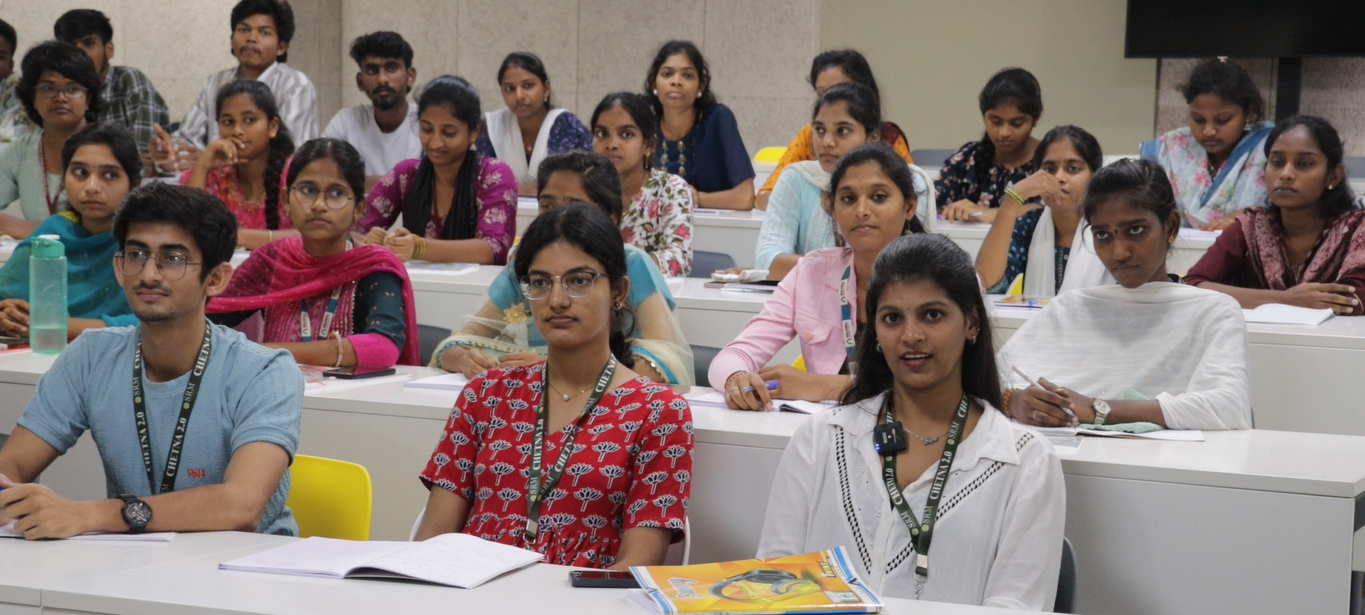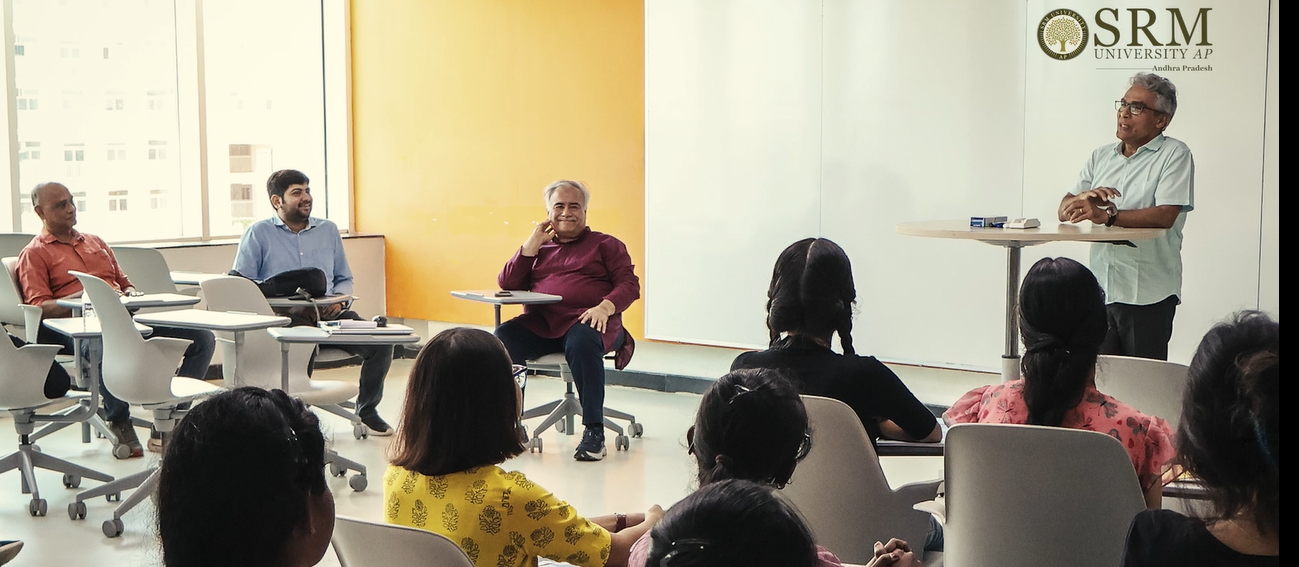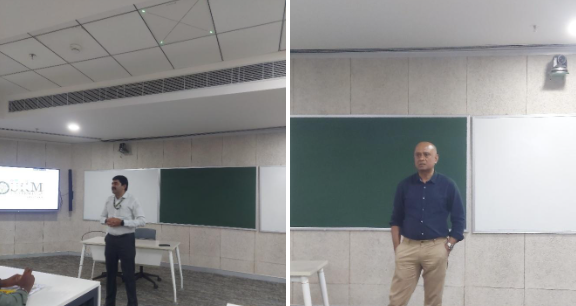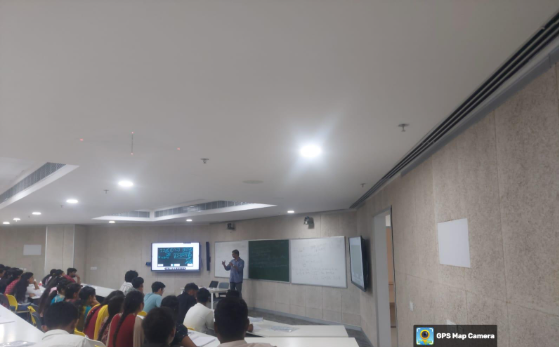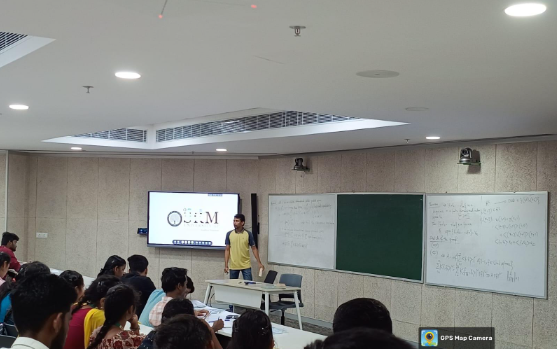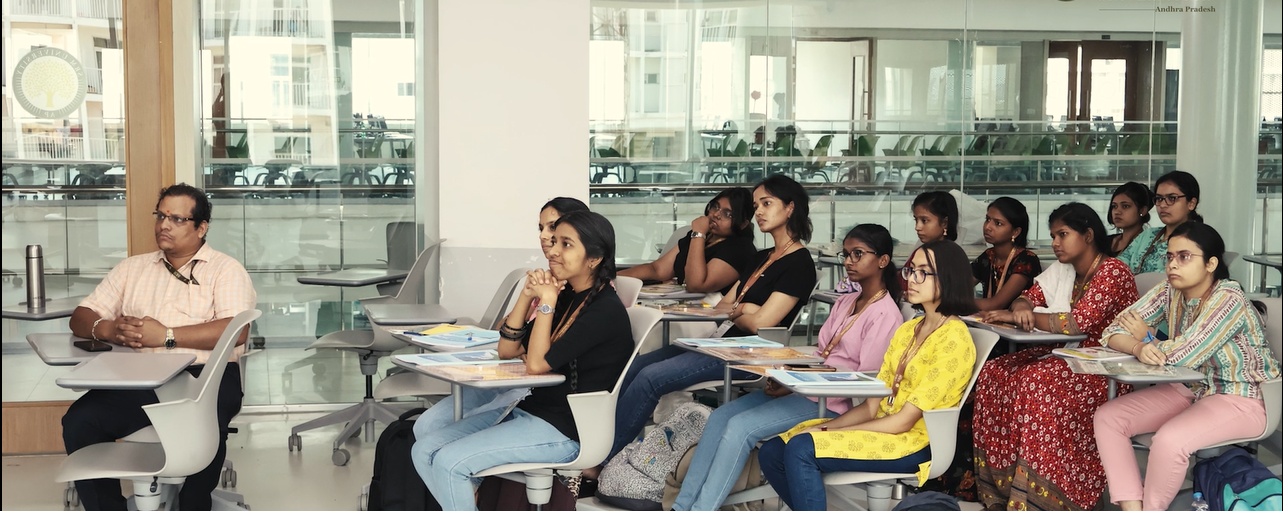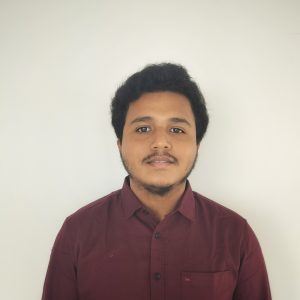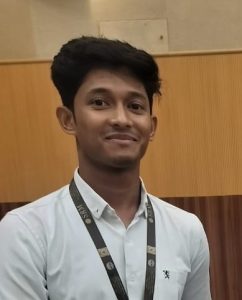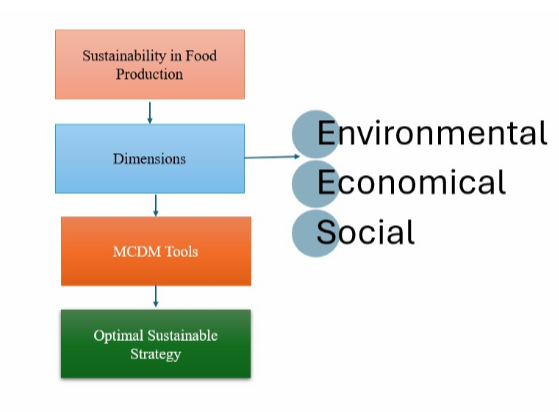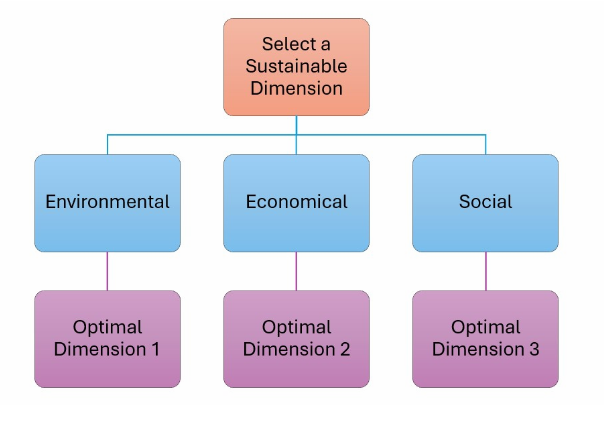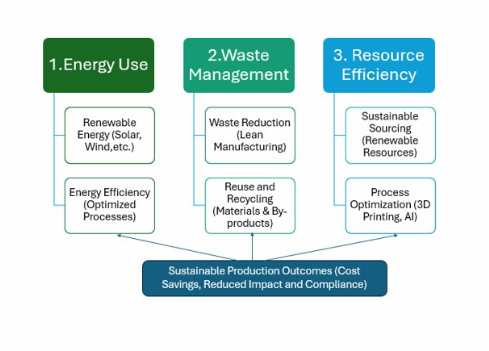SRM University-AP Marks International Yoga Day with Community and Consciousness
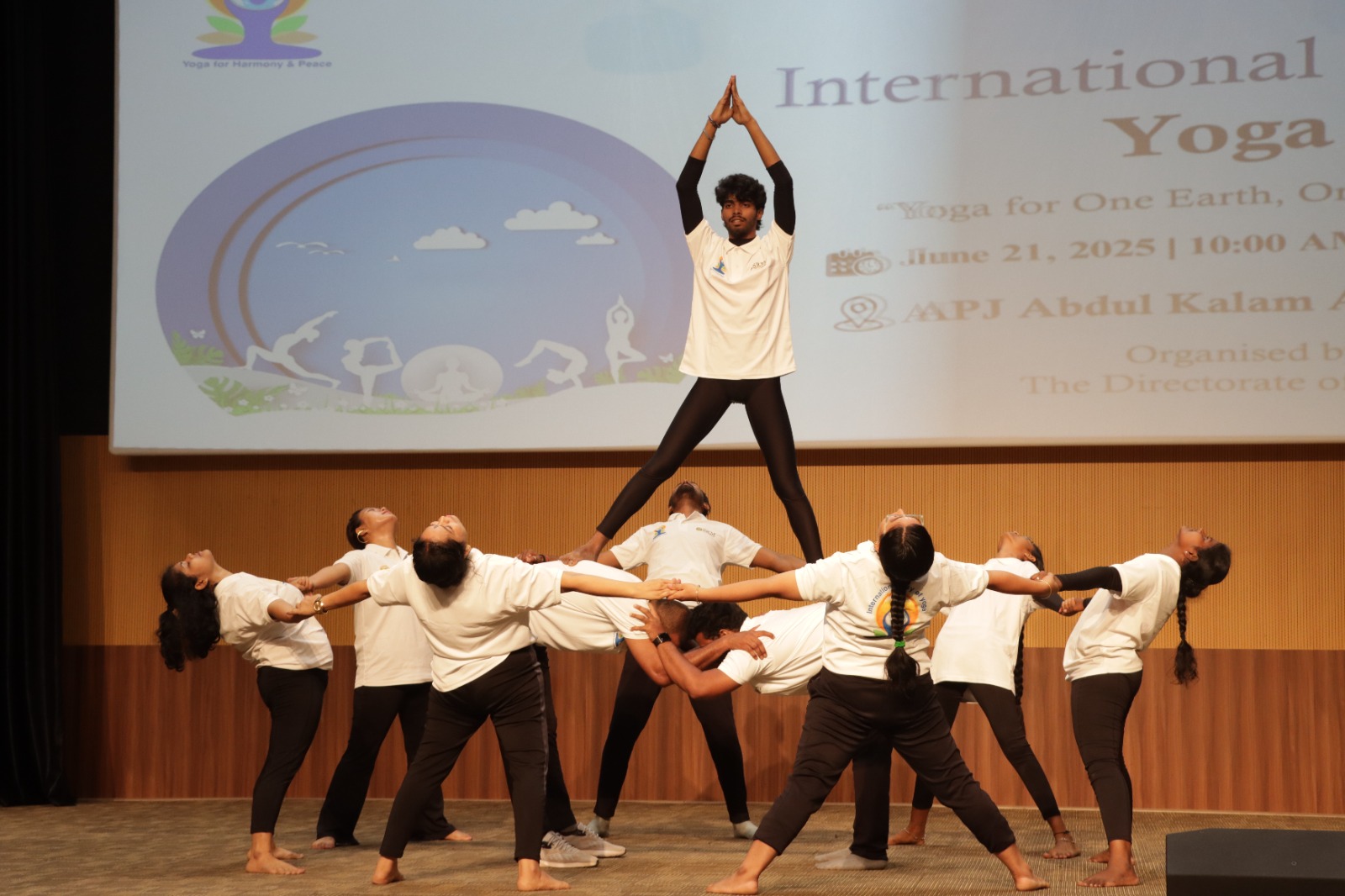 SRM University-AP, Amaravati, marked International Yoga Day on June 21 with a spirited celebration, as students, faculty, and staff united in a vibrant display of mindfulness and harmony. The event saw the participation of around 200 attendees and featured diverse yoga styles including fusion, micro, artistic, and group yoga sessions.
SRM University-AP, Amaravati, marked International Yoga Day on June 21 with a spirited celebration, as students, faculty, and staff united in a vibrant display of mindfulness and harmony. The event saw the participation of around 200 attendees and featured diverse yoga styles including fusion, micro, artistic, and group yoga sessions.
Led by Yoga instructor Ms Moni, the demonstrations were energetic and engaging, inspiring all to embrace the practice. The Directorate of Sports, under the leadership of Director Mr Anup Singh Suryavanshi, organised the event seamlessly, spreading the message of holistic wellness.
The ceremony began with a warm welcome address by Dr Sushmita Kumar, Assistant Director of Sports. She remarked, “The world is celebrating the heritage of India. Yoga reflects the timeless influence of our ancient traditions on modern life. It transcends generations and geographical boundaries, promoting awareness and physical strength. This year’s theme, Yoga for One Earth, One Health, reinforces Vasudhaiva Kutumbakam—a Sanskrit phrase meaning ‘The world is one family”. This emphasises the importance of caring for ourselves and the planet alike.”
Vice-Chancellor Prof. Manoj K Arora spoke about the deeper significance of yoga, stating, “June 21 marks an important planetary alignment where energies are high, which is why it must have been chosen for International Yoga Day. To connect with the Supreme, one must be healthy physically, mentally, emotionally, and spiritually. True health is the alignment of all these dimensions.”
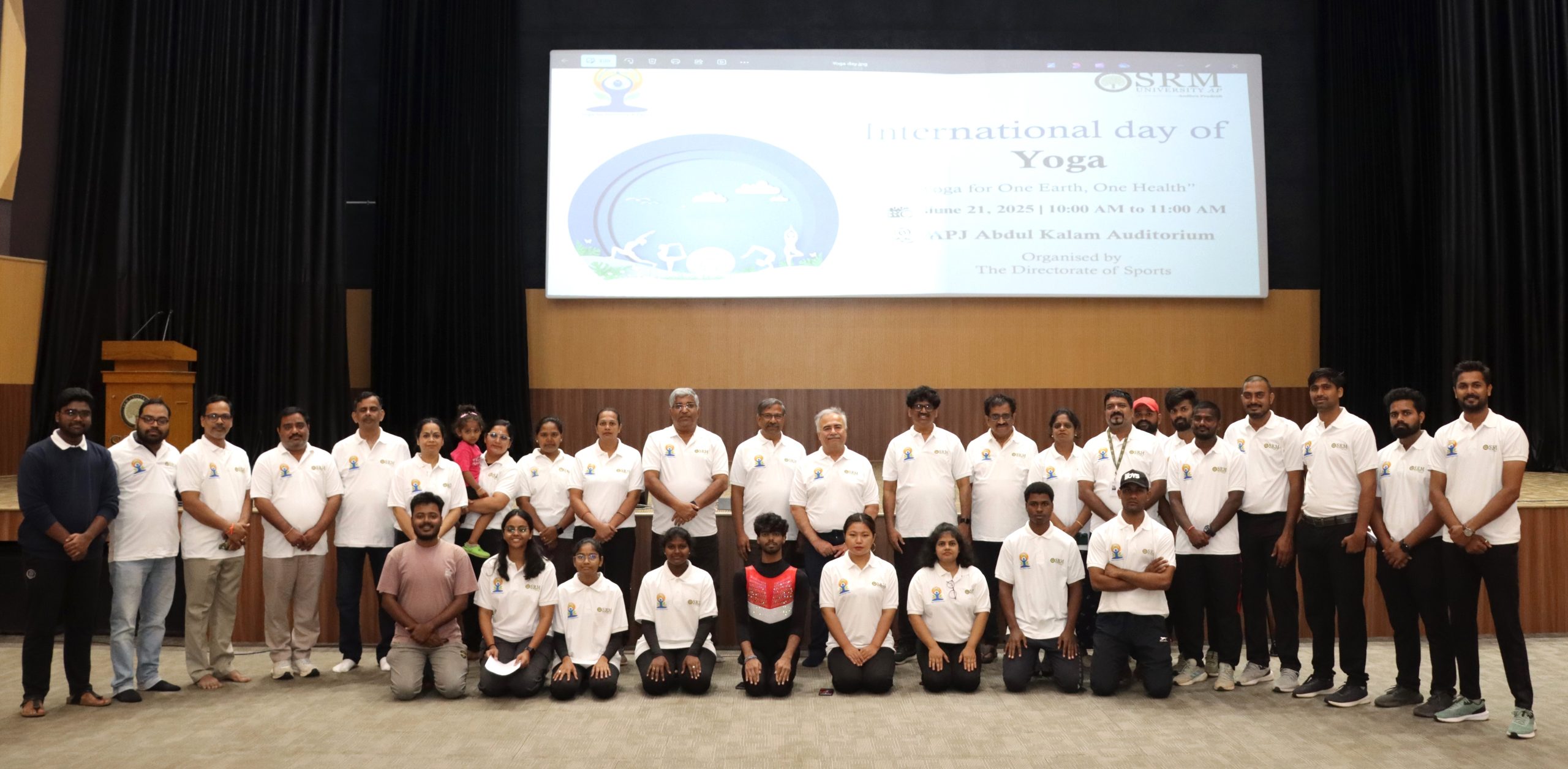
He added, “Yoga is not merely a physical exercise, it involves breathwork, emotional balance, and spiritual connection. Only when all aspects of well-being are in harmony can we live truly fulfilling lives. This alignment, in fact, is what education ultimately seeks to achieve along with intellectual and economic well-being .”
Pro Vice-Chancellor, Dr Satish Kumar, echoed this sentiment and described yoga as India’s timeless gift to the world, stressing that it should be a daily practice rather than an annual observance. “Thousands of years ago, Patanjali gifted us this profound practice. While other countries have brought different things to the world some positive, some harmful, India has given the world yoga: peace, culture, and a way of life. Even just 10 to 15 minutes of yoga daily can transform your well-being. Make it a part of your routine,” he urged.
Earlier in the day, Ms Moni also conducted yoga sessions at the Government High School in Neerukonda, where young students participated with enthusiasm. She further led yoga sessions for around 90 participants, including men and women from nearby villages, who actively engaged in the community-driven initiative.
- Published in News, Sports News
GAA-NSFET Biosensor for High-Sensitivity Label-Free Detection
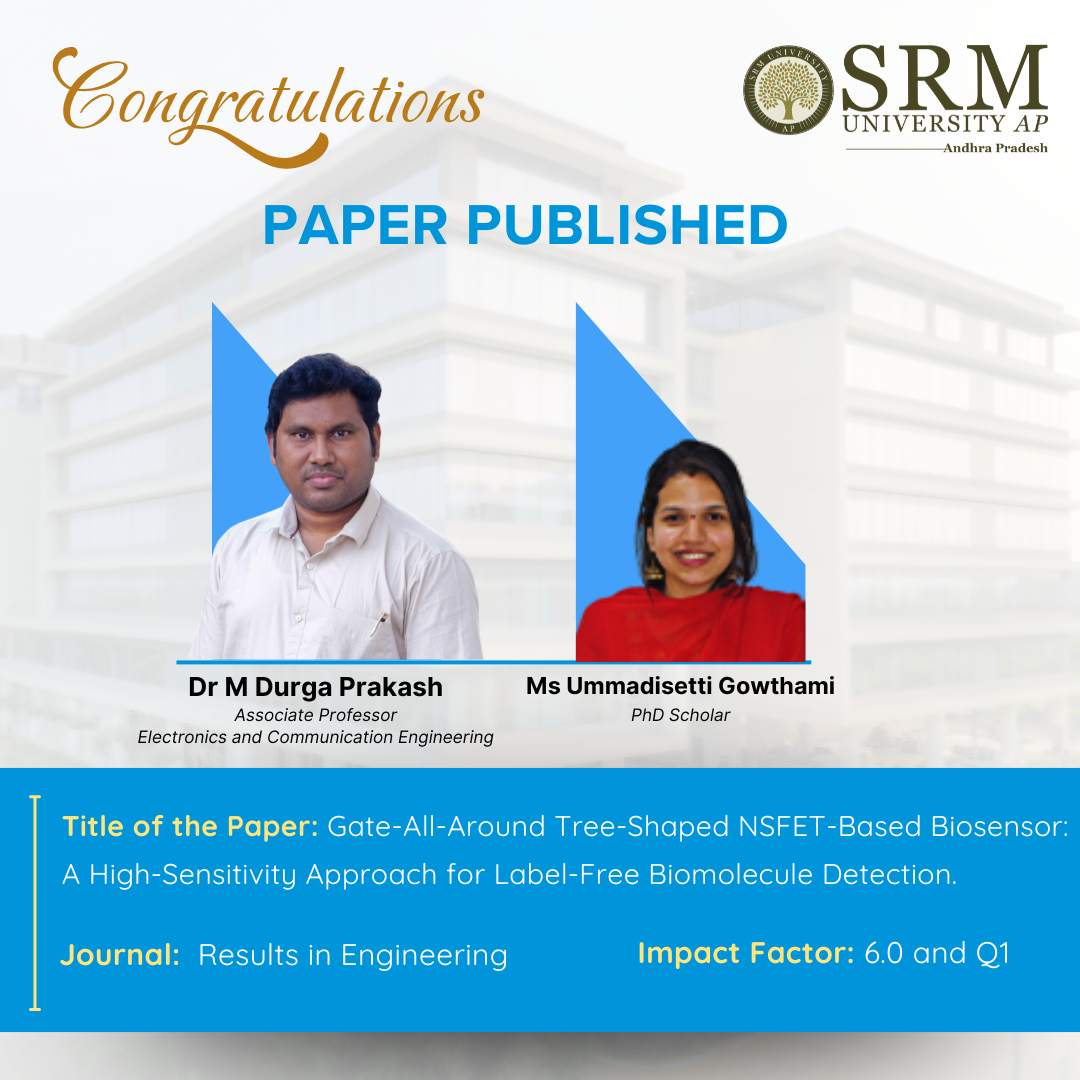 A cutting-edge research paper titled “Gate-All-Around Tree-Shaped NSFET-Based Biosensor: A High-Sensitivity Approach for Label-Free Biomolecule Detection” led by Dr M Durga Prakash, Associate Professor in the Department of Electronics and Communication Engineering, and Ms U Gowthami, PhD Scholar, has been published in the prestigious Q1 journal “Results in Engineering” with an Impact Factor of 6.0.
A cutting-edge research paper titled “Gate-All-Around Tree-Shaped NSFET-Based Biosensor: A High-Sensitivity Approach for Label-Free Biomolecule Detection” led by Dr M Durga Prakash, Associate Professor in the Department of Electronics and Communication Engineering, and Ms U Gowthami, PhD Scholar, has been published in the prestigious Q1 journal “Results in Engineering” with an Impact Factor of 6.0.
This study presents a groundbreaking advancement in label-free biosensing technology by developing a highly sensitive biosensor. The device can detect extremely small biological molecules—such as proteins and DNA—without the need for traditional labeling methods that rely on fluorescent or radioactive tags. At the core of this innovation is a uniquely engineered transistor known as the Gate-All-Around Tree-Shaped Nanosheet Field-Effect Transistor (GAA-TS-NSFET). With its distinctive tree-like structure featuring multiple nanosheet branches, this advanced transistor design enables the detection of both charged and neutral biomolecules with exceptional sensitivity.
Abstract :
This paper proposes and investigates a label-free dielectrically modulated biosensor employing a Gate All Around Tree-Shaped Nanosheet Field Effect Transistor (GAA-TS-NSFET). The suggested biosensor’s excellent sensitivity to charged and neutral biomolecules is demonstrated by its electrical properties when evaluated under various biomolecule influences.
A thorough sensitivity assessment is used to assess the sensing capabilities of the biosensors with various channel configurations. As indicators of biosensor sensitivity variation, we examine the subthreshold swing (SS), threshold voltage (Vth), and current switching ratio (Ion/Ioff). According to the findings, an additional channel acts as an interbridge, allowing the tree-shaped biosensor to attain the best sensitivity compared to biosensors based on NSFETs. Additionally, the article investigates how various spacer materials impact sensitivity. We also run several scenarios to see how different fill percentages affect the proposed biosensor’s sensitivity. The amount of biomolecules present determines its sensitivity. Finally, the suggested biosensor’s sensitivity is compared to other notable biosensing application efforts in a status map. The proposed GAA-TS-NSFET-based biosensor outperforms the previous works concerning Ion/Ioff sensitivity.
Practical Implementation of the Research
- Faster & Cheaper Diagnostics – Reduces reliance on expensive lab tests, making healthcare more accessible.
- Early Disease Detection – Could save lives by catching illnesses (like cancer or infections) at earlier stages.
- Less Invasive Testing – Since it doesn’t require labeling (no dyes or radioactive tags), it’s safer and simpler.
- Environmental Benefits – Could replace some chemical-based detection methods with electronic sensing, reducing waste.
Collaborations: School of Engineering, University of Warwick, Coventry CV4 7AL United Kingdom
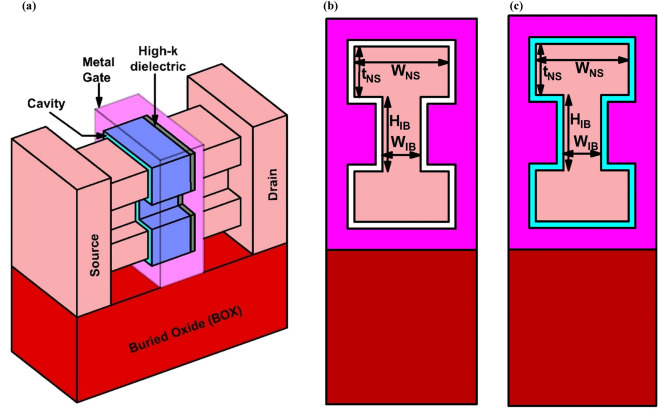
Fig. (a) 3-D view of GAATree-shaped NSFET-based biosensor; Transverse cross-sectional view of GAA Tree-shaped NSFET-based biosensor: (b) from source side and (c) from drain side.
- Published in Departmental News, ECE NEWS, News, Research News
“Class and Inequality in China and India” Talk by Prof. Vamsi Vakulabharanam
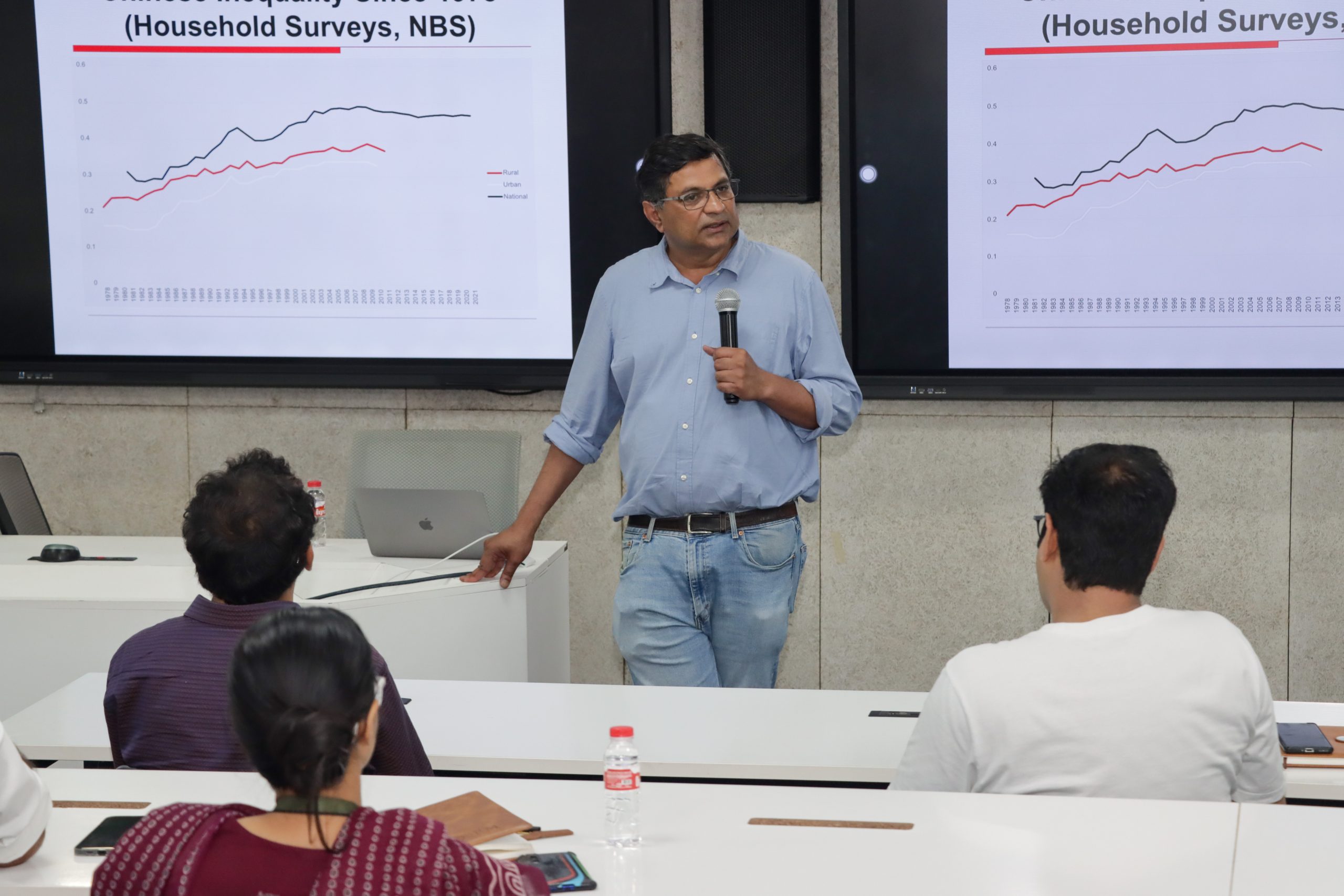 The Department of Economics hosted a talk titled “Class and Inequality in China and India” by Prof. Vamsi Vakulabharanam, Associate Professor of Economics at the University of Massachusetts Amherst on June 17th. Prof. Vakulabharanam, a former faculty member at the University of Hyderabad and City University of New York, has been associated with research institutions such as the Institute for New Economic Thinking (INET) and the India China Institute. He is a renowned scholar in the field of political economy, inequality and development studies with a focus on India, global capitalism and class-caste dynamics.
The Department of Economics hosted a talk titled “Class and Inequality in China and India” by Prof. Vamsi Vakulabharanam, Associate Professor of Economics at the University of Massachusetts Amherst on June 17th. Prof. Vakulabharanam, a former faculty member at the University of Hyderabad and City University of New York, has been associated with research institutions such as the Institute for New Economic Thinking (INET) and the India China Institute. He is a renowned scholar in the field of political economy, inequality and development studies with a focus on India, global capitalism and class-caste dynamics.
In his talk, Prof. Vakulabharanam presented key ideas from his recent book Class and Inequality in India (1950–2010), offering a comparative political economy perspective on India and China. His lecture offered critical comparative insights into the evolution of class structures and inequalities in China and India, two of the world’s largest emerging economies.
Drawing on empirical evidence and theoretical perspectives, the speaker examined the socio- economic trajectories of both countries and highlighted the implications of rising disparities for long- term development and social stability. He traced two distinct phases in the post-independence period:1950–1980, marked by low economic growth but a decline in inequality (forming the lower part of a U-shape), and 1980–2010, characterised by rapid growth under neoliberal reforms and policies but a simultaneous rise in inequality.
The lecture highlighted three main contributions of the book:
- A class-based analysis of inequality, especially novel in the context of China.
- An exploration of how India and China have transformed the world economy post-1950, and how global economic dynamics have, in turn, reshaped these countries.
- A theoretical framework for understanding within-country inequality.
Prof. Vakulabharanam also engaged with frameworks such as varieties of capitalism, French regulation theory, and comparative urban inequality (e.g., urban Gini coefficient analysis in Beijing and Delhi), offering a nuanced critique on ideas from thinkers like Thomas Piketty and Simon Kuznets and of global inequality discourse.
Concluding his talk, Prof. Vakulabharanam emphasised, “If China and India genuinely want to add something novel to the world order, they have to break free from the European model and find their own way of addressing inequality, climate change, and technological innovation.”
The session witnessed active participation from faculty members and research scholars from the Easwari School. Followed by a lively Q&A session, engaging participants in discussions around development policy, economic reforms, and the political economy of inequality. This academic event marked a valuable opportunity for the university community to interact with an international expert and gain deeper understanding of comparative development challenges in Asia.
- Published in Departmental News, Economics Current Happenings, Economics News, News
Chetna 2.0: Awakening Mathematical Minds
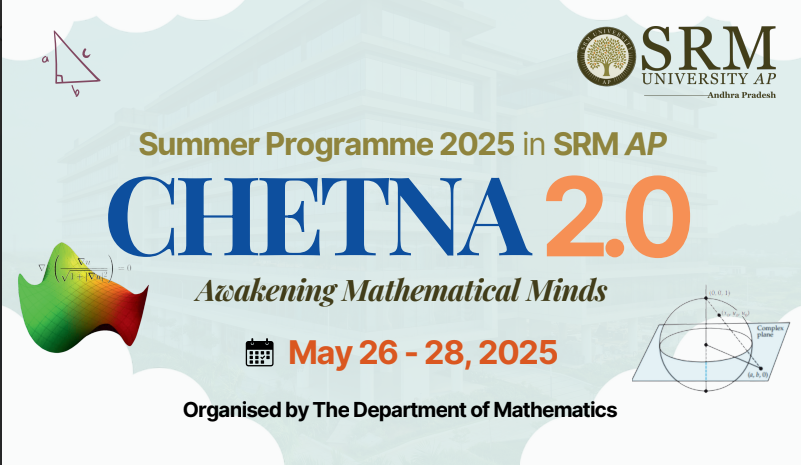 The Department of Mathematics at SRM University-AP, Amaravati, successfully conducted a three-day summer programme, Chetna 2.0: Awakening Mathematical Minds, from May 26th to May 28th, 2025. The programme aimed to inspire and deepen mathematical understanding among students nationwide. A total of 84 enthusiastic participants joined from various states, including Madhya Pradesh, Kerala, Tamil Nadu, Maharashtra, and Andhra Pradesh.
The Department of Mathematics at SRM University-AP, Amaravati, successfully conducted a three-day summer programme, Chetna 2.0: Awakening Mathematical Minds, from May 26th to May 28th, 2025. The programme aimed to inspire and deepen mathematical understanding among students nationwide. A total of 84 enthusiastic participants joined from various states, including Madhya Pradesh, Kerala, Tamil Nadu, Maharashtra, and Andhra Pradesh.
The curriculum was thoughtfully designed to cover a broad spectrum of mathematical topics. Faculty members from the Department of Mathematics led sessions on various subjects, offering a rich and engaging learning experience that ignited a more profound passion for mathematics among the attendees.
Varadha from Kerala shared, “I was able to build on my knowledge from my BSc and learn entirely new concepts. Each faculty member brought their own unique teaching style, which helped boost our confidence, curiosity, and understanding.”
Dr Kalyan Banerjee, Assistant Professor in the Department of Mathematics, noted, “At SRM-AP, we have a thriving mathematics department. We hope that during this three-day programme, students will gain valuable insights from our faculty and be introduced to advanced concepts in higher mathematics such as geo-mathematics, applied mathematics, and data science—all trending areas in today’s mathematical landscape. We aim to highlight mathematics’s crucial role in science and technology.”
Speakers List
Prof. Kalyan Chakraborty
Dr Shilpa Garai
Dr Krishanu Roy
Dr Vijayakrishna Rowthu
Dr Animesh Bhandari
Dr Kalyan Banerjee
Dr Priyabrata Mandal
Dr Prakash Chandra
Dr Jayasree Subramanian
Conclusion:
Chetna 2.0: Awakening Mathematical Minds was a resounding success, offering students valuable knowledge and a deeper appreciation for mathematics. The blend of participants from diverse backgrounds and the expertise of the faculty created a dynamic and stimulating environment. The Department of Mathematics at SRM University-AP looks forward to hosting similar initiatives in the future to continue nurturing young mathematical talent across the nation.
- Published in Departmental News, Math News, News
SRM University-AP Ranks No.1 as “The New-Age Emerging University” by IIRF 2025
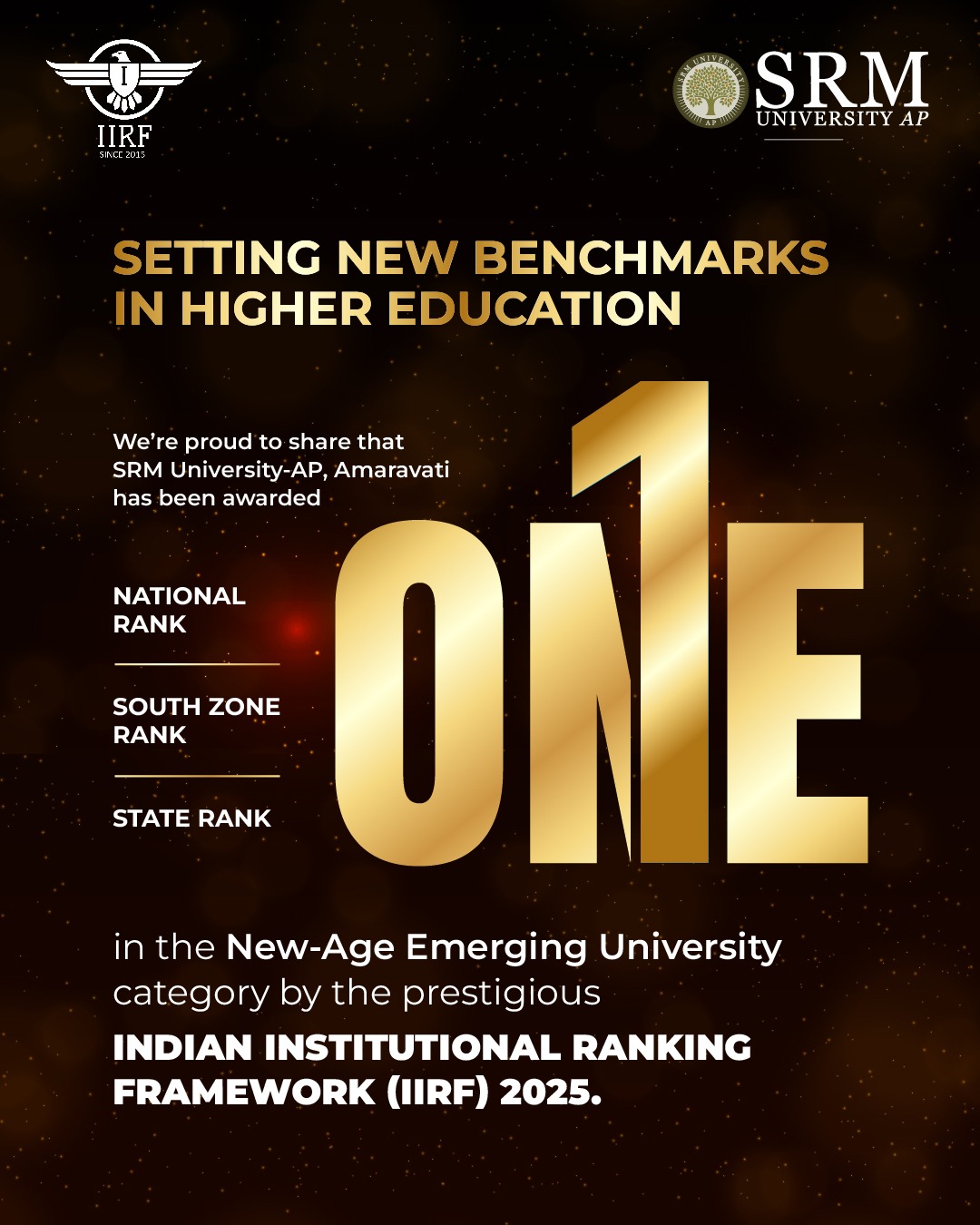 Adding another prestigious accolade to its growing list of achievements, SRM University-AP, Amaravati, secured the top position in “The New-Age Emerging University” segment by the Indian Institutional Ranking Framework (IIRF) 2025 under the Private University category.
Adding another prestigious accolade to its growing list of achievements, SRM University-AP, Amaravati, secured the top position in “The New-Age Emerging University” segment by the Indian Institutional Ranking Framework (IIRF) 2025 under the Private University category.
The IIRF evaluated leading educational institutions across the country based on comprehensive metrics, including Teaching-Learning Resources and Pedagogy, Research, Industry Income and Integration, Placement Strategies and Support, Future Orientation, External Perception and International Outlook. These parameters offer a balanced and holistic assessment, providing students, parents, and educators with an objective framework to evaluate institutional quality and performance.
SRM University-AP achieved top scores across these critical benchmarks and claimed the top spot, reaffirming its position as a university committed to academic excellence, impactful faculty research, and transformative student outcomes.
Dr P Sathyanarayana, Pro Chancellor, SRM University-AP, added, “The journey of SRM-AP has always been about pushing boundaries, whether in pedagogy, research, or student empowerment. Securing this top rank further validates our vision of creating a future-ready, student-centric learning ecosystem. We will continue to embrace innovation and strive for even greater heights.”
Prof. Manoj K Arora, Vice Chancellor of SRM University-AP, expressed his delight, stating, “This recognition by IIRF is a testament to the dedication and innovation of our faculty, students, and staff. At SRM-AP, we are not just building a University, we are nurturing future leaders who are ready to thrive in a dynamic world. Our focus on cutting-edge research, industry collaboration, and a global outlook continues to set us apart as a new-age university.”
The university’s holistic approach, marked by multi-disciplinary learning, international partnerships, and robust industry linkages, is paving the way for its students to become global achievers.
- Published in Awards and Rankings, News
HackVyuha’25 National-Level Hackathon – Where innovation meets impact
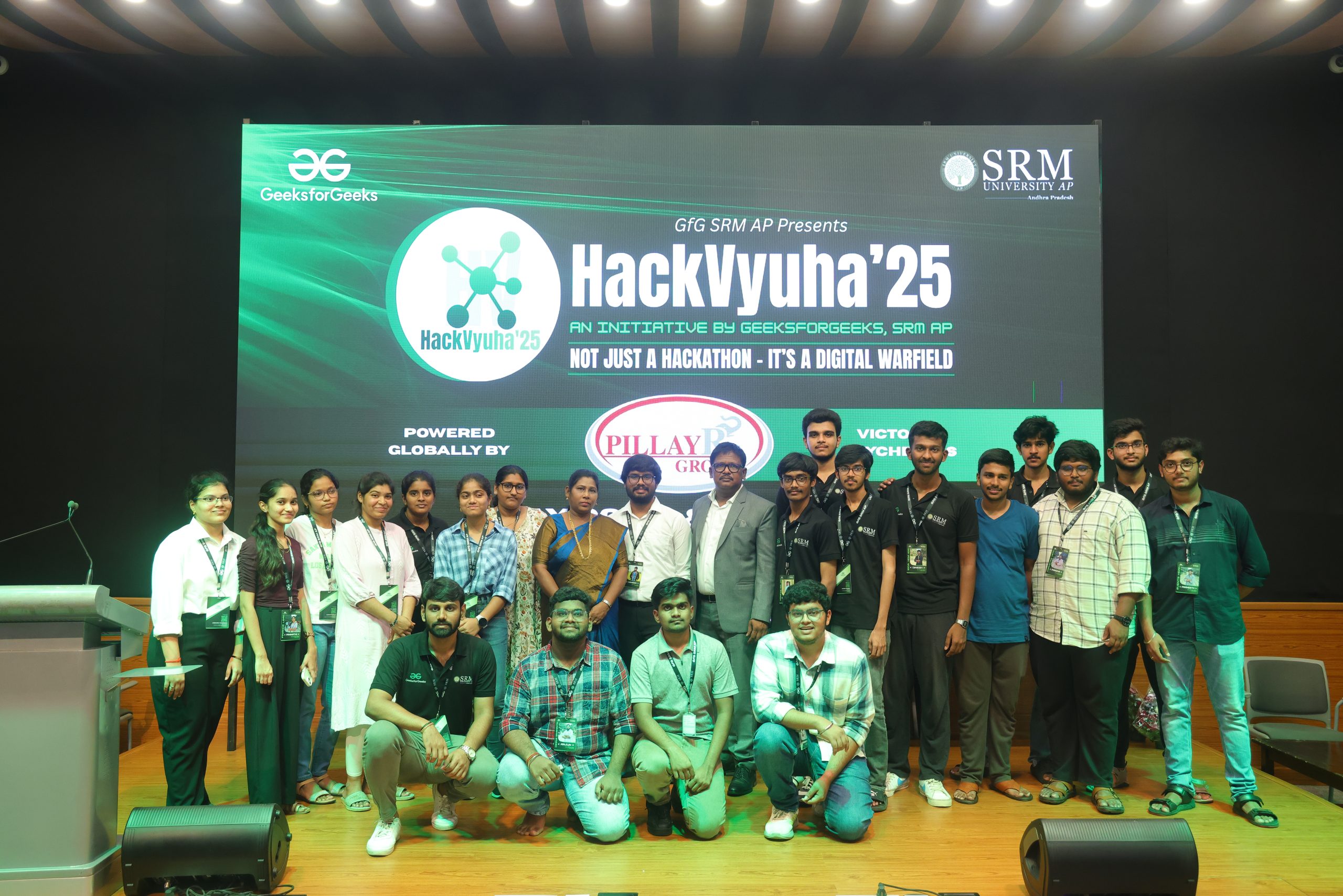 HackVyuha’25, a three-day national-level hackathon, was organised by GeeksforGeeks Student Chapter on campus. The event provided a platform for students to explore real-world problem statements, apply emerging technologies, and transform ideas into tangible prototypes. The event was powered by Pillay R Group.
HackVyuha’25, a three-day national-level hackathon, was organised by GeeksforGeeks Student Chapter on campus. The event provided a platform for students to explore real-world problem statements, apply emerging technologies, and transform ideas into tangible prototypes. The event was powered by Pillay R Group.
The Hackathon saw more than 230 student innovators from about 30 educational institutions across the country including Rajalakshmi Institute of Technology (Chennai), SR University (Warangal), RGUKT (Nuzvid), Amrita Vishwa Vidyapeetham (Coimbatore), SRM Institute of Science and Technology (Kattankulathur), and several other institutes from Telangana, Tamil Nadu, Karnataka, and Andhra Pradesh.
The event was organised by the GeeksforGeeks Student Chapter at SRM University- AP, Amaravati, led by Mahesh Babu Chittem, a B.Tech 2nd year student, under the supervision of Dr Ashok Kumar Pradhan, Associate Professor from the Department of Computer Science Engineering and Faculty Advisor of the GfG SRM AP Chapter.
The HackVyuha’25 initiative began with an online Idea Submission Round. Over 200 innovative ideas were received from 30+ participating institutions across India, with 1,364 individual registrations. The top 50 teams were shortlisted for the offline prototype round held at SRM- AP, during the main event.
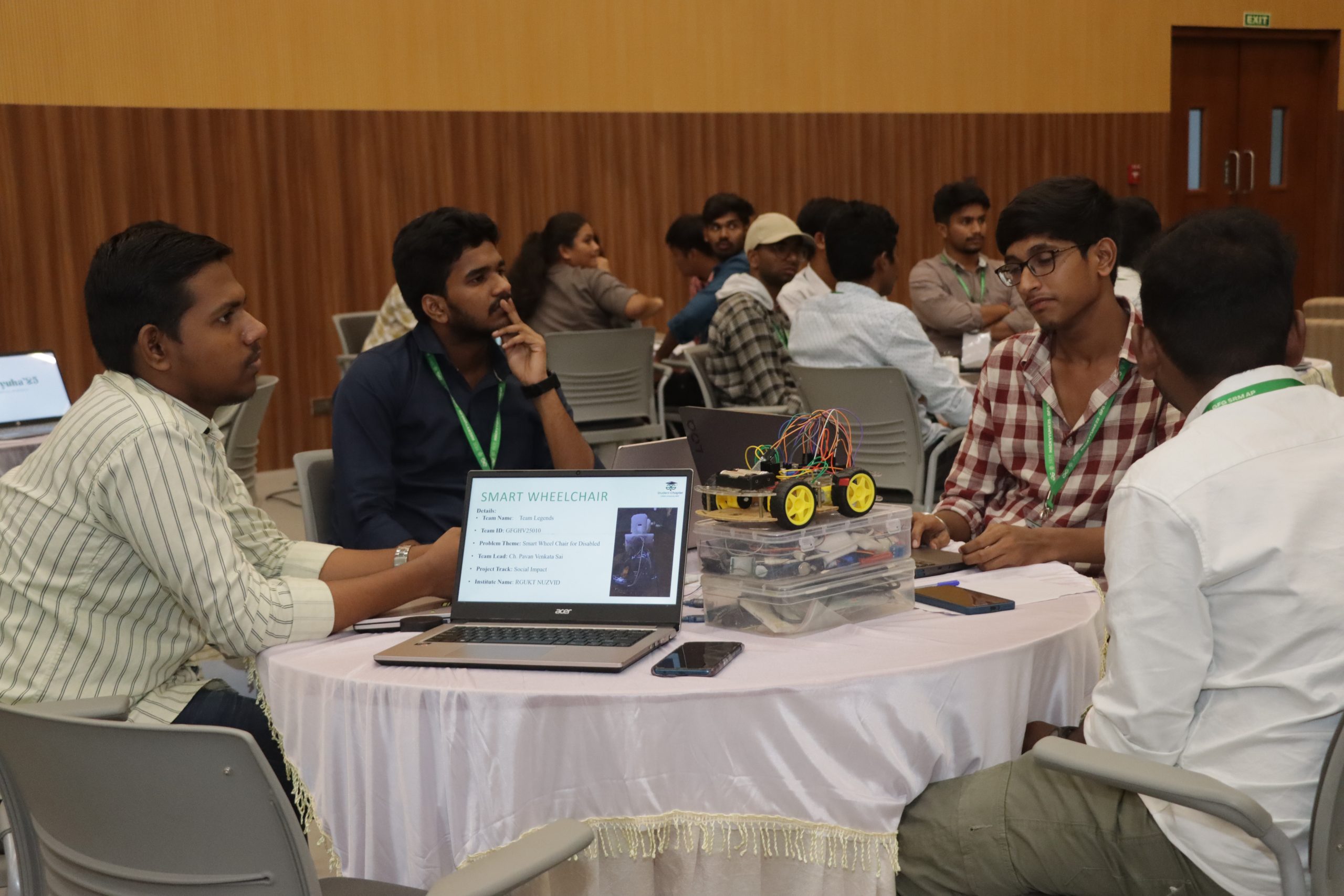
The event began with a grand Inaugural Session hosted by Mahesh Babu Chittem, Guests of Honour included Dr Ashok Kumar Pradhan, Associate Professor, CSE & Faculty Advisor of the GfG Chapter, Dr Murali Krishna Enduri, Head of the Department of Computer Science and Engineering, Dr Pankaj Belwariar, Director of Communications, SRMAP, Prof. C V Tomy, Dean of the School of Engineering and Sciences, SRMAP, Dr C Sree Rama Prabhu, Director of Research and Innovation at KMIT, and Dr Kumar Gautam, Founder & CEO of QRACE (Quantum Research and Centre of Excellence), New Delhi.
The hackathon witnessed 50+ shortlisted teams from across India settling into their workspaces in the APJ Abdul Kalam Auditorium on Day-2. A surprise visit by former Telangana Minister Mr Malla Reddy delighted the students, who toured the event floor and interacted with multiple teams. A panel of professionals reviewed initial prototypes, assessed team progress, and provided constructive feedback. The evaluators appreciated the diversity of ideas presented, especially those focused on social impact and climate tech.
On Day-3, all teams submitted their final working demos and documentation. Judges conducted an in-depth analysis of the usability, implementation, UI/UX, and relevance of each project. The top 5 teams were shortlisted and invited to pitch live before the grand jury in the X-Lab Auditorium. Each team was evaluated for scalability, presentation clarity, and innovation under pressure.
The Valedictory Ceremony was hosted by Mahesh Babu Chittem, where guest speakers Dr Ashok Kumar Pradhan, Prof. C V Tomy, and Mr Devadas Gorrela, Operations Manager, Pillay R Group, spoke on how hackathons mirror real business strategy, encouraging students to refine their ideas into startups.
The Team Tech Titans conferred first Prize with a cash prize of Rs. 25,000 while the second Prize was won by Team Tech Sparks with Rs 15,000 and Technites settled for third Prize with a Rs. 10,000 cash price, each team receiving a trophy and certificate. A special felicitation was conducted for all 25+ evaluators, who were honored with appreciation certificates and thanked on stage with a small present.
- Published in News
Accelerating SVM Computations Using an FPGA-Based Embedded System
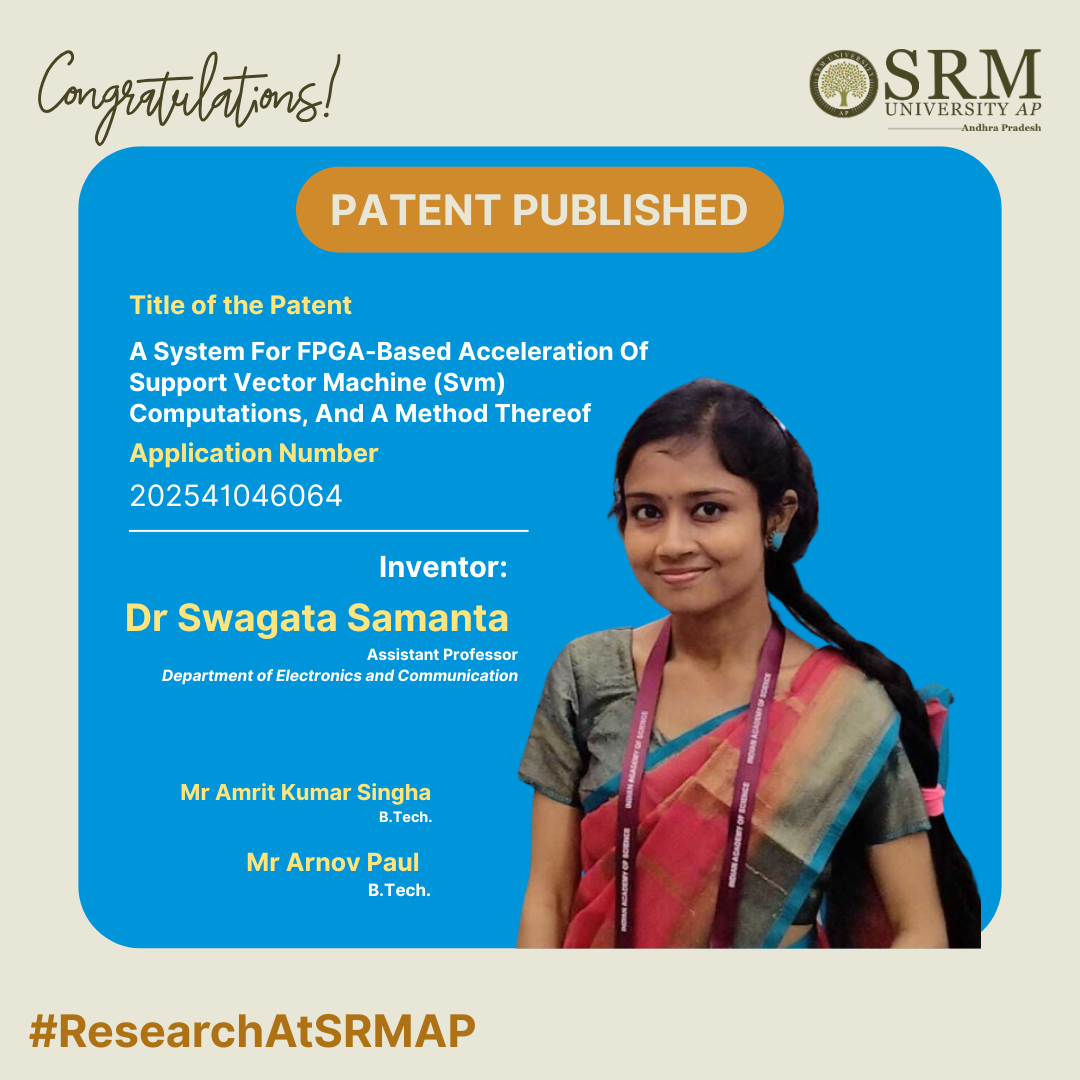 In a commendable stride toward advancing edge AI technology, Dr Swagata Samanta, Assistant Professor in the Department of Electronics and Communication Engineering along with B.Tech students Amrit Kumar Singha and Arnov Paul, have successfully filed and published a patent titled “A System for FPGA-based Acceleration of Support Vector Machine (SVM) Computations, and a Method Thereof” in Patent Office Journal.
In a commendable stride toward advancing edge AI technology, Dr Swagata Samanta, Assistant Professor in the Department of Electronics and Communication Engineering along with B.Tech students Amrit Kumar Singha and Arnov Paul, have successfully filed and published a patent titled “A System for FPGA-based Acceleration of Support Vector Machine (SVM) Computations, and a Method Thereof” in Patent Office Journal.
The patented system introduces a novel approach to speeding up machine learning algorithms specifically Support Vector Machines by implementing them on Field-Programmable Gate Array (FPGA)-based embedded systems. By harnessing the capabilities of Xilinx’s Vitis High-Level Synthesis (HLS), the team was able to develop a hardware-accelerated solution that dramatically enhances computational efficiency while simplifying the design process through C++-based abstraction.
Abstract:
By utilising the power and flexibility of FPGAs, the aim is to enhance the performance and efficiency of these compute-intensive tasks without delving into the intricate low-level hardware details. The approach involves implementing the fundamental concepts of SVM algorithms using the Vitis HLS design flow provided by Xilinx. Vitis HLS allows us to describe these algorithms at a higher level of abstraction using C++, enabling faster development and easier optimisation compared to traditional HDL- based designs.
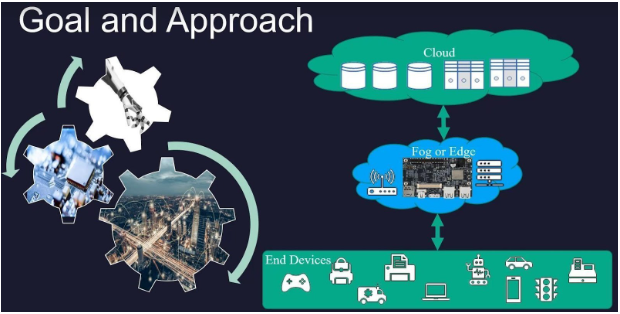
By leveraging the capabilities of Xilinx Zynq-based embedded systems, we can efficiently accelerate these algorithms and improve overall system performance. GDS2 is a standard file format used for representing integrated circuit layouts, playing a crucial role in the physical design and fabrication of FPGAs by capturing the geometric and connectivity information of components such as logic blocks, interconnects, and I/O pads.
Proper GDS2 layout design is essential for ensuring manufacturability, optimising performance, maximising area utilisation, and maintaining signal integrity within an FPGA, taking into account physical constraints and design rules imposed by the fabrication process to minimise signal propagation delays, reduce power consumption, optimise timing, achieve higher density, minimise wasted space, and employ proper routing and shielding techniques to minimise crosstalk, signal reflections, and other signal integrity issues. By combining the power of HLS using Vitis with the Cadence GDS2 layout design, this project aims to accelerate SVM algorithms on FPGA-based embedded systems.
The use of Vitis HLS simplifies the development process and enhances productivity, while the GDS2 layout design ensures manufacturability, performance optimisation, efficient area utilisation, and signal integrity. This work showcases the potential of using FPGAs for hardware acceleration of machine learning algorithms, opening up new possibilities for embedded systems in various domains such as computer vision, natural language processing, and data analytics.
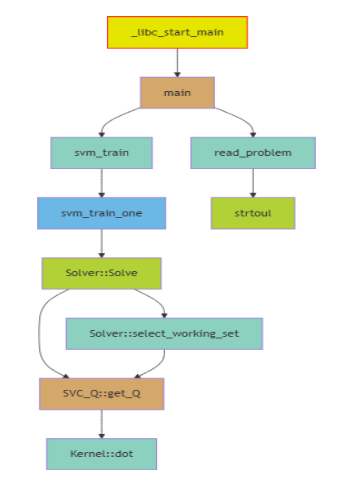
Implementation and Impact:
This work advances machine learning on FPGAs by optimising SVM algorithms for speed via parallel processing, supporting multiple ML models, and using Vitis HLS for efficient hardware-software co-design, while reducing power consumption and enabling scalability through multi-FPGA or hybrid systems; we’ll test in real-world IoT, automotive, and medical applications, compress models with pruning and quantisation, transition to ASICs for mass production, and develop standardised interfaces and on-device learning to enhance privacy and adaptability.
These advancements could make AI more accessible for low-cost medical diagnostics or smart devices in underserved areas, reduce carbon footprints through energy efficiency, boost economic growth through job creation, and improve safety in self-driving cars and smart homes. However, ethical design is crucial to prevent bias or misuse and ensure equitable benefits across society.
Future Directions:
Building on this foundation, the team plans to expand their architecture to support additional ML models, deepen hardware-software co-design efforts, and implement on-device learning for adaptive, privacy-preserving intelligence. Long-term goals also include transitioning to custom ASIC implementations for mass production and developing standardised interfaces to enhance system interoperability.
- Published in Departmental News, ECE NEWS, News, Research News
Blockchain and Analytical Hierarchy Process (AHP) in food systems
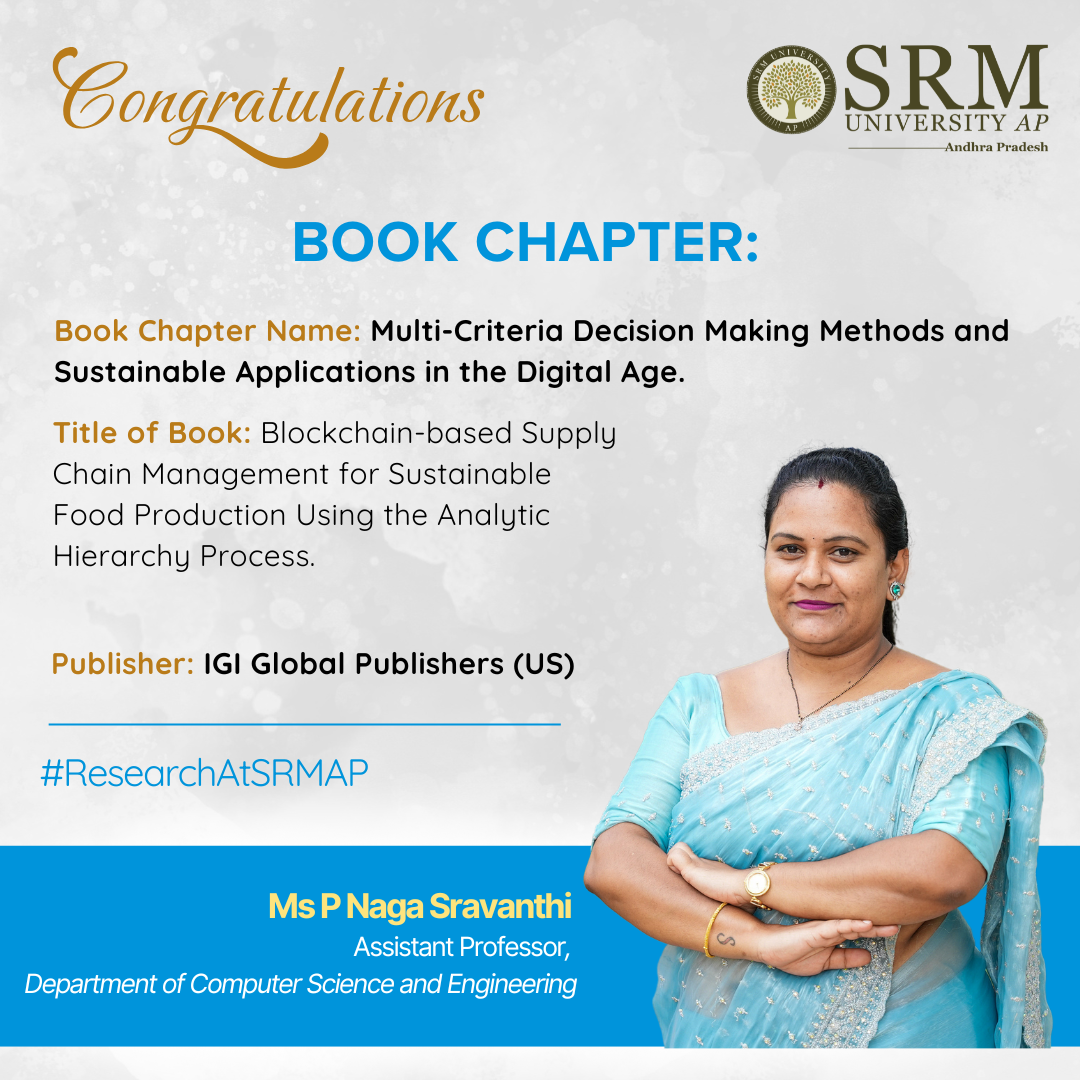 Have you ever questioned whether the food on your plate is truly fresh—or where it was grown?
Have you ever questioned whether the food on your plate is truly fresh—or where it was grown?
The efficiency of our food supply chain is often undermined by challenges such as limited traceability, poor communication, and rising labor costs. These disruptions can lead to food safety concerns, spoilage, and increased costs. Hence there’s a growing need for better tracking and transparency throughout the entire supply chain.
Addressing these issues, P Naga Sravanthi, Assistant Professor in the Department of Computer Science and Engineering, published a chapter titled “ Multi-Criteria Decision Making Methods and Sustainable Applications in the Digital Age” in the book Blockchain-based Supply Chain Management for Sustainable Food Production Using the Analytic Hierarchy Process (AHP) by IGI Global Publishers (US).
The chapter explores how blockchain can be incorporated into the food supply chain and used to track every step of the food journey. The Analytical Hierarchy Process (AHP) helps assess critical metrics like quality, cost, or environmental impact. AHP provides a transparent platform to improve food systems and make sustainable choices for all stakeholders, including farmers, sellers, and consumers.
Abstract:
This chapter discusses how blockchain technology can build transparent and trustworthy food supply chains. It combines blockchain technology with the Analytic Hierarchy Process (AHP), a structured method to rank and prioritise sustainability goals, including reducing waste, ensuring freshness, and supporting local farmers. This approach guides food producers in making smarter, eco-conscious decisions, helping them align with global sustainability goals while improving production and distribution efficiency.
Societal Impact:
This research can make a massive difference in the real-world scenario. Farmers can trace their products, suppliers can avoid fraud, and customers can get safe and fresh food. It also supports small-scale producers by giving them a voice in the supply chain. Governments and companies can use this system to ensure sustainability, reduce food loss, and build public trust in food safety and fair trade.
Future Plans :
Looking ahead, the goal is to test this blockchain-AHP model in farm-to-fork supply chains, especially in rural or emerging markets. Collaborations with agricultural cooperatives and food tech startups are in progress. Machine learning will also be integrated to improve real-time decision-making. Future research will focus on policy frameworks and community-based blockchain adoption to expand its impact on sustainable food production.
- Published in CSE NEWS, Departmental News, News, Research News
Building Stronger Futures: Eco-Friendly, High-Strength Mortar
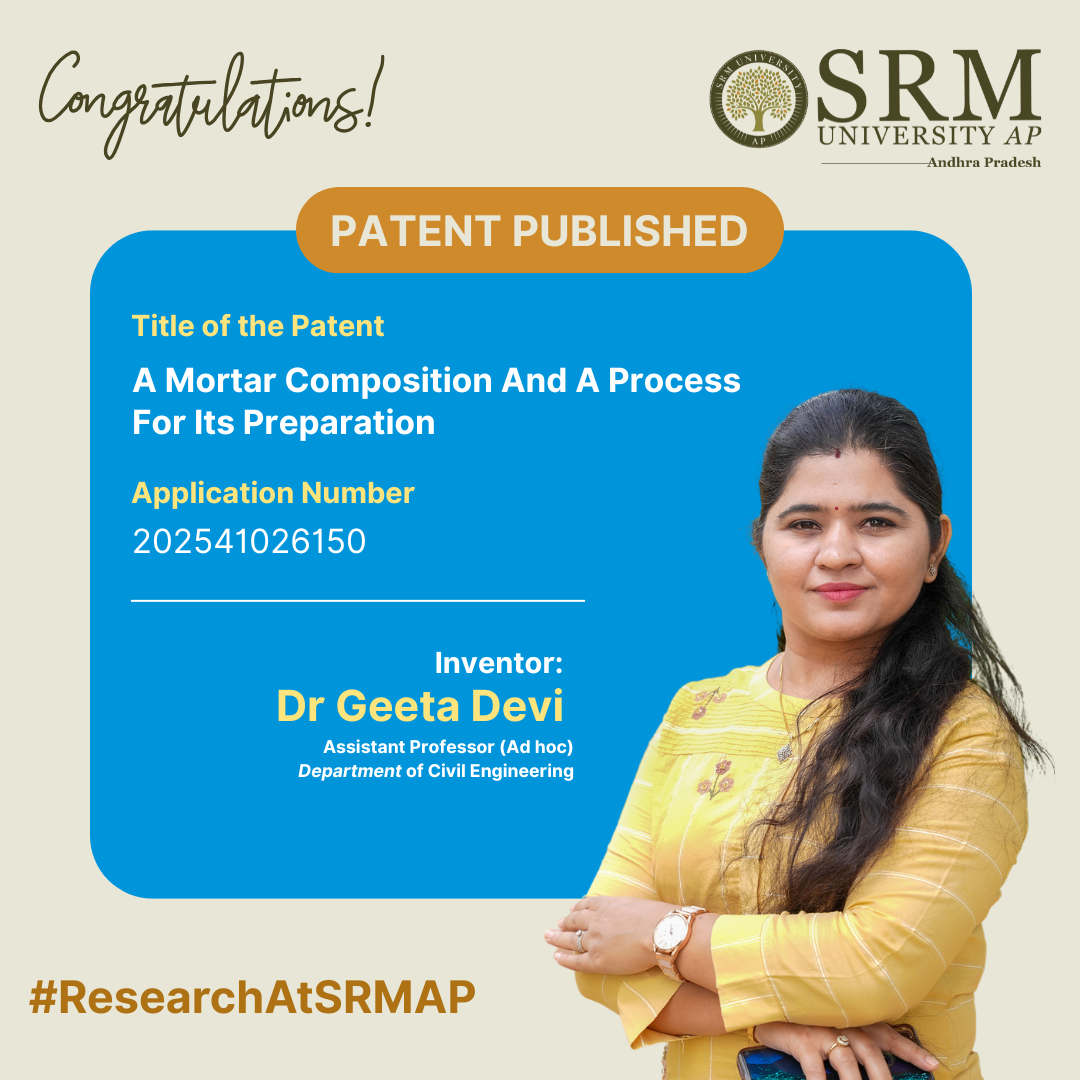 In a significant breakthrough for sustainable construction, a new and improved version of traditional cement mortar has been developed by Dr Geeta Devi, Assistant Professor, Department of Civil Engineering along with Dr Mohanraj Rajendran, Assistant Professor, and Mr Lokeshwaran Murugan, M.Tech Scholar have filed and published a patent titled “A Mortar Composition and a Process for its Preparation”.
In a significant breakthrough for sustainable construction, a new and improved version of traditional cement mortar has been developed by Dr Geeta Devi, Assistant Professor, Department of Civil Engineering along with Dr Mohanraj Rajendran, Assistant Professor, and Mr Lokeshwaran Murugan, M.Tech Scholar have filed and published a patent titled “A Mortar Composition and a Process for its Preparation”.
This enhanced mortar becomes stronger and more durable while setting faster to reduce construction time. The improved formula absorbs less water, increasing its resistance to moisture and weather damage. It also provides better workability, making it easier to apply on construction sites. This innovation saves both time and cost in construction projects while delivering longer-lasting structural integrity, making it a valuable advancement for the building industry.
Abstract
The research presents an innovative mortar composition and a simple, scalable process for its preparation, designed to improve construction quality and efficiency. This innovative formulation incorporates polyester fibers (Recron 3s). It employs water with controlled Total Dissolved Solids (TDS) levels, resulting in remarkable improvements in compressive and flexural strength, faster setting times, and reduced water absorption. This novel formulation demonstrates up to 21.5% improvement in strength and offers a practical, eco-friendly solution for modern construction needs.
A new and improved version of traditional cement mortar has been developed by adding Recron 3s polyester fibers to the mix and controlling the mixing water quality through Total Dissolved Solids (TDS) level adjustments. This enhanced mortar becomes stronger and more durable while setting faster to reduce construction time. The improved formula absorbs less water, increasing its resistance to moisture and weather damage, while also providing better workability that makes it easier to apply on construction sites. This innovation saves both time and cost in construction projects while delivering longer-lasting structural integrity, making it a valuable advancement for the building industry.
Practical Implementation & Social Impact
This new mortar composition is particularly tailored for practical use in real-world construction, including residential buildings, educational institutions like schools and colleges and infrastructure projects like bridges, pavements and stable structures for harsh environments. Some of the key performance improvements are the enhanced durability giving long-term strength, Faster setting time aiding quicker construction and better water resistance, minimising damage and deterioration.
Using this mortar composition in construction could reduce maintenance and repair costs by extending the lifespan of structures. It also supports sustainable practices by utilising recyclable polyester fibres (Recron 3s). The ability to utilise non-potable water with controlled Total Dissolved Solids (TDS) levels makes the process both eco-friendly and cost-effective in regions with limited access to clean water resources. This innovation contributes meaningfully to Sustainable Development Goals (SDGs) in infrastructure and housing, particularly in resource-limited or climate-sensitive areas.
Future Research Plans
- Scaling the mortar production for industry use.
- Exploring nano-materials and industrial by-products to further improve mortar performance and reduce environmental impact.
- Testing the composition under extreme climate conditions and integrating it with 3D printing in construction.
- Investigating automated mixing systems and AI-based optimisation of mix design for site-specific applications.
Research Team
Dr Geeta Devi – Assistant Professor, SRM University-AP
Dr Mohanraj Rajendran – Assistant Professor, SRM University, Delhi NCR
Mr Lokeshwaran Murugan – M.Tech Scholar, SRM University, Delhi NCR
- Published in CIVIL NEWS, Departmental News, News, Research News
Breakthrough in Nanosecond Laser Conversion for Clean Energy
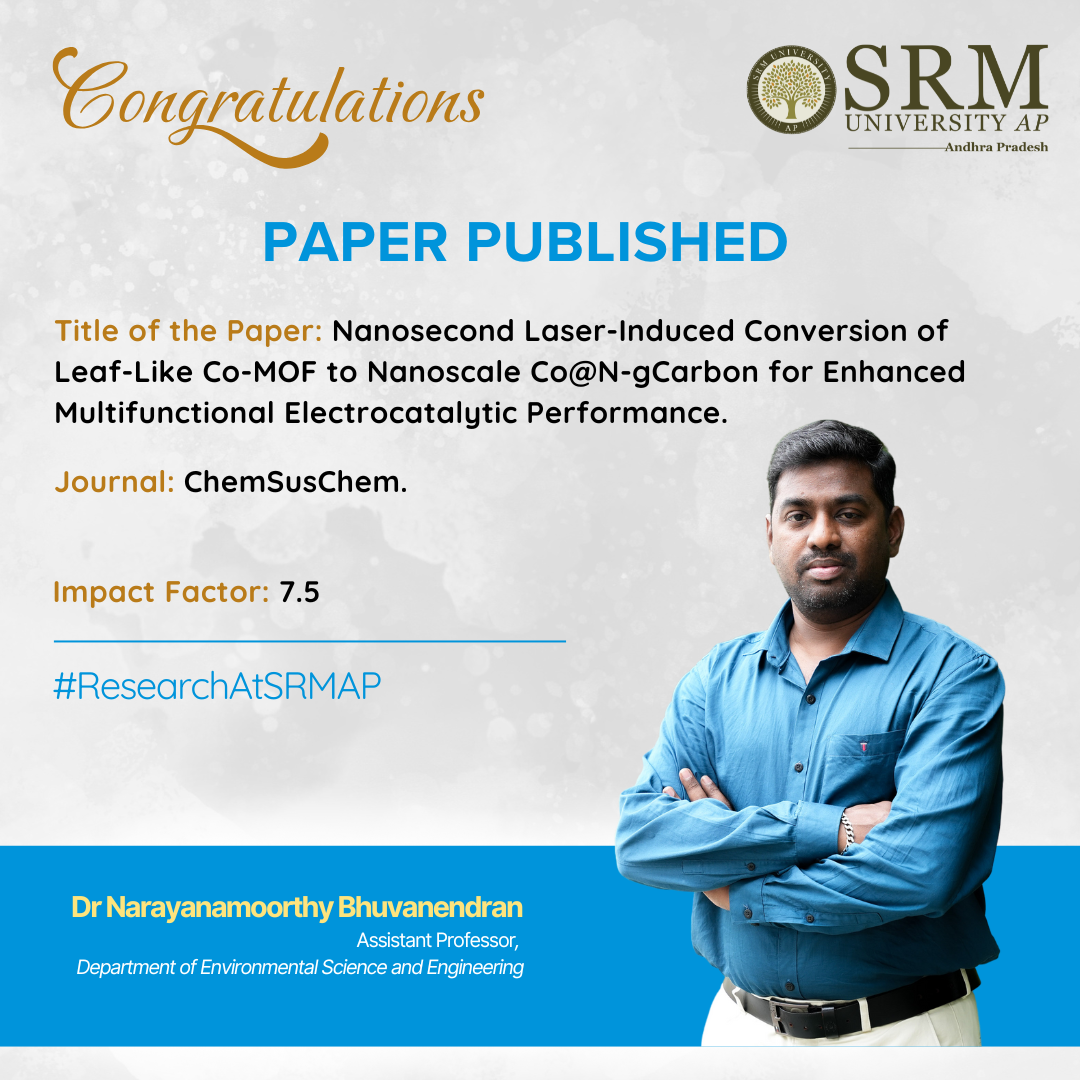
The paper titled “Nanosecond Laser-Induced Conversion of Leaf-Like Co-MOF to Nanoscale Co@N-gCarbon for Enhanced Multifunctional Electrocatalytic Performance” by Dr Narayanamoorthy Bhuvanendran, Assistant Professor, Department of Environmental Science and Engineering, was published in the ChemSusChem journal with a Q1 rating with an impact factor of 7.5. The study presents a breakthrough in clean energy research with an innovative nanosecond laser-based technique that transforms metal–organic frameworks into high-performance electrocatalysts faster, more energy-efficiently, and eco-friendly.
Abstract :
Conversion of metal–organic frameworks (MOFs) into metal-nitrogen-doped carbon (M–N–C) catalysts requires a high-temperature process and longer processing time under a protective atmosphere. This study utilises a low-energy nanosecond laser processing (LP) technique to convert aqueous synthesised 2D leaf-like Co-MOF (L-Co-MOF) into nanoscale cobalt metal encapsulated within a nitrogen-doped graphitic carbon matrix (Co@N-gC, Co-LP) in a shorter period under air atmosphere.
The laser-induced process results in the formation of Co@N-gC with smaller Co particle size, uniform distribution, and better interaction with the carbon support compared to the conventional pyrolysis process (CP). LP catalysts result in enhanced multifunctional electrocatalytic activity over CP (Co-CP) catalysts owing to the tunable metal–support interaction, higher charge transfer, and presence of multiactive sites.
Under optimised conditions (laser fluence: 5.76 mJ cm−2 and scan speed: 10 mm s−1), the Co-LP-5 catalyst exhibits better ORR performance, with onset and half-wave potentials of 0.92 and 0.76 V, respectively. Additionally, Co-LP-5 delivers excellent water-splitting performance, with OER and HER overpotentials of 380 and 280 mV, respectively, achieving an overall energy efficiency of 77.85%. Furthermore, Co-LP-5 demonstrates exceptional durability over 48 h of real-time testing, outperforming the Co-CP, and the proposed low-energy LP is viable for fabricating multifunctional catalysts.
The research focuses on developing new materials for more efficient clean energy production, specifically advanced catalysts that accelerate chemical reactions. Traditionally, creating an effective M–N–C (metal–nitrogen–carbon) catalyst requires heating metal-organic frameworks (MOFs) to high temperatures in oxygen-free environments, which is time-consuming and energy-intensive.
This study introduces a simpler, faster, and energy-saving approach using nanosecond laser pulses to transform cobalt-containing MOFs into a new material called Co@N-gC. This laser method operates in normal air, significantly reducing time and energy consumption. The resulting catalyst features smaller, evenly distributed cobalt particles that enhance interaction with the carbon support, leading to improved activity and efficiency in key energy reactions. Our laser-made catalyst, Co-LP-5, exhibited excellent performance over 48 hours, outperforming traditional methods. This breakthrough demonstrates that low-energy laser techniques can create powerful, multifunctional catalysts for clean energy more quickly, cheaply, and sustainably.
Practical implementation of the research :
We are working on developing new materials that help produce clean energy in a faster, cheaper, and more eco-friendly way. Usually, scientists use a high-heat process to convert materials called metal-organic frameworks (MOFs) into something called catalysts, which are substances that help speed up important chemical reactions, such as splitting water to produce hydrogen fuel or helping batteries and fuel cells work better.
However, the traditional method requires a lot of energy, time, and special conditions to work. In the study, we found a much simpler and faster way to make these useful catalysts. Instead of heating the material for a long time, we used a laser to quickly transform the MOF into a new material. We did this in normal air using short pulses of light from a laser, and within seconds, the material changed into a highly active form containing tiny cobalt particles surrounded by nitrogen-rich carbon. This new material works more efficiently and lasts longer than the one made by traditional heating.
Our method is not only quicker and more energy-efficient, but also easier to scale up for larger use. This laser technique can be used to create advanced materials for fuel cells, batteries, and systems that produce hydrogen from water. These technologies are crucial for clean energy and can help reduce pollution and dependence on fossil fuels.
The real-world impact of this research is significant. It can make clean energy technologies more affordable and accessible, especially in developing regions with limited energy access. It also supports the shift toward a greener economy by promoting sustainable methods and creating new opportunities in clean energy industries. In the long term, this work contributes to fighting climate change and protecting the environment by helping the world move toward cleaner, safer energy solutions.
Future Research Plans:
- Explore using different metal-based MOFs to develop a broader range of catalysts for clean energy applications.
- Optimise laser processing conditions such as energy, speed, and environment to improve the quality and performance of the final materials.
- Study the detailed mechanism of how the laser converts MOFs into active catalysts to better understand and control the process.
- Test the laser-made catalysts in actual energy devices like fuel cells and water-splitting systems to evaluate their real-world performance.
- Investigate methods to scale up the laser processing technique for larger production while keeping it cost-effective and energy efficient.
- Expand the application of these materials to other areas such as carbon dioxide reduction, hydrogen storage, or environmental sensing.
Collaborations:
Prof. Sae Youn Lee, Dongguk University, Republic of Korea.
Dr. Srinivasan Arthanari, Chungnam National University, Republic of Korea.
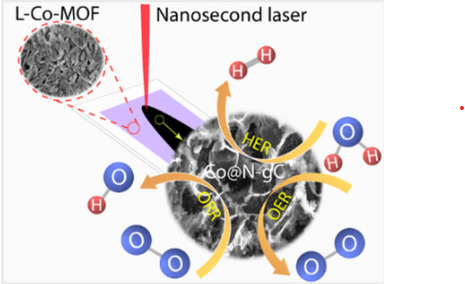
- Published in Departmental News, ENVS News, News, Research News


